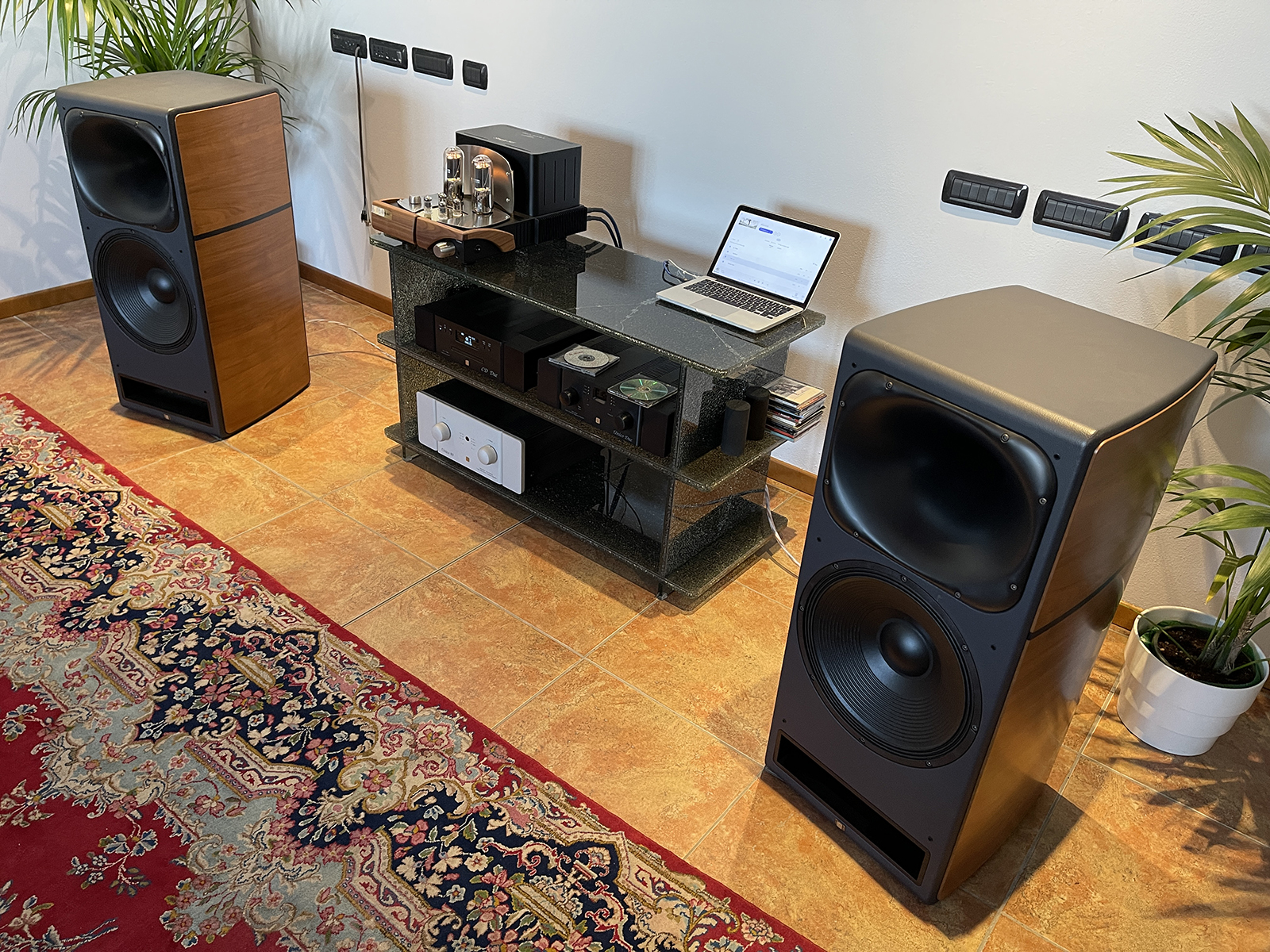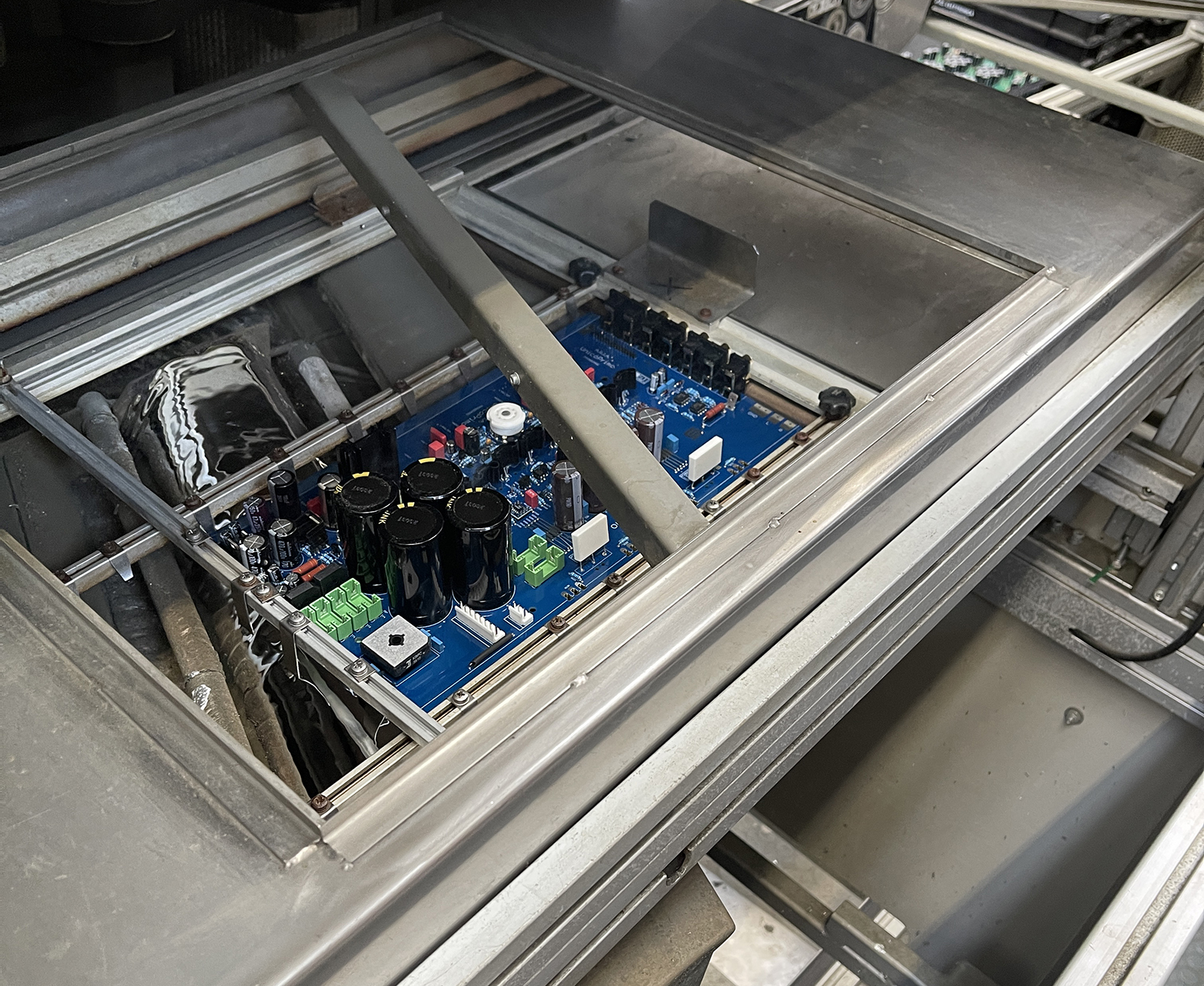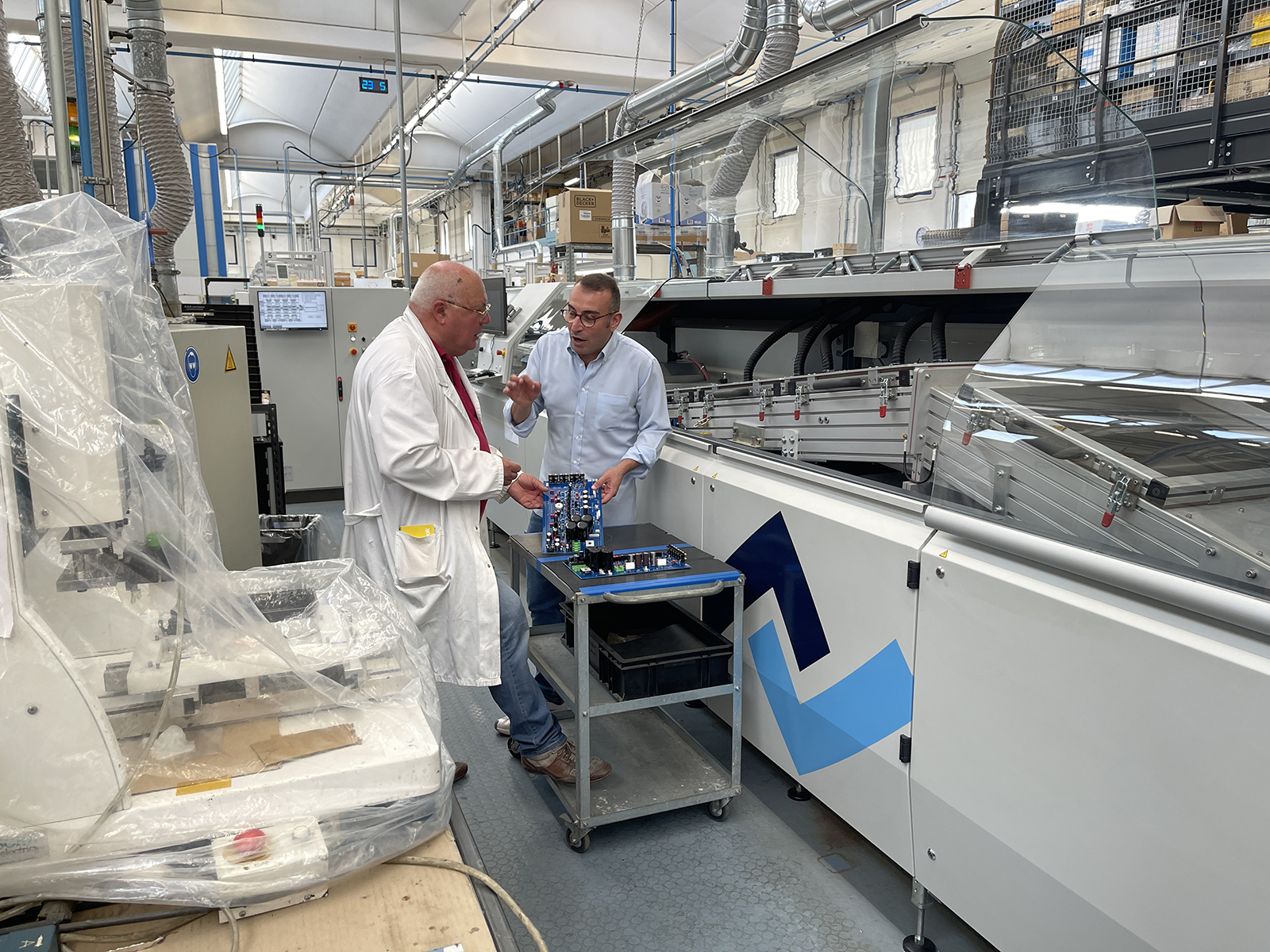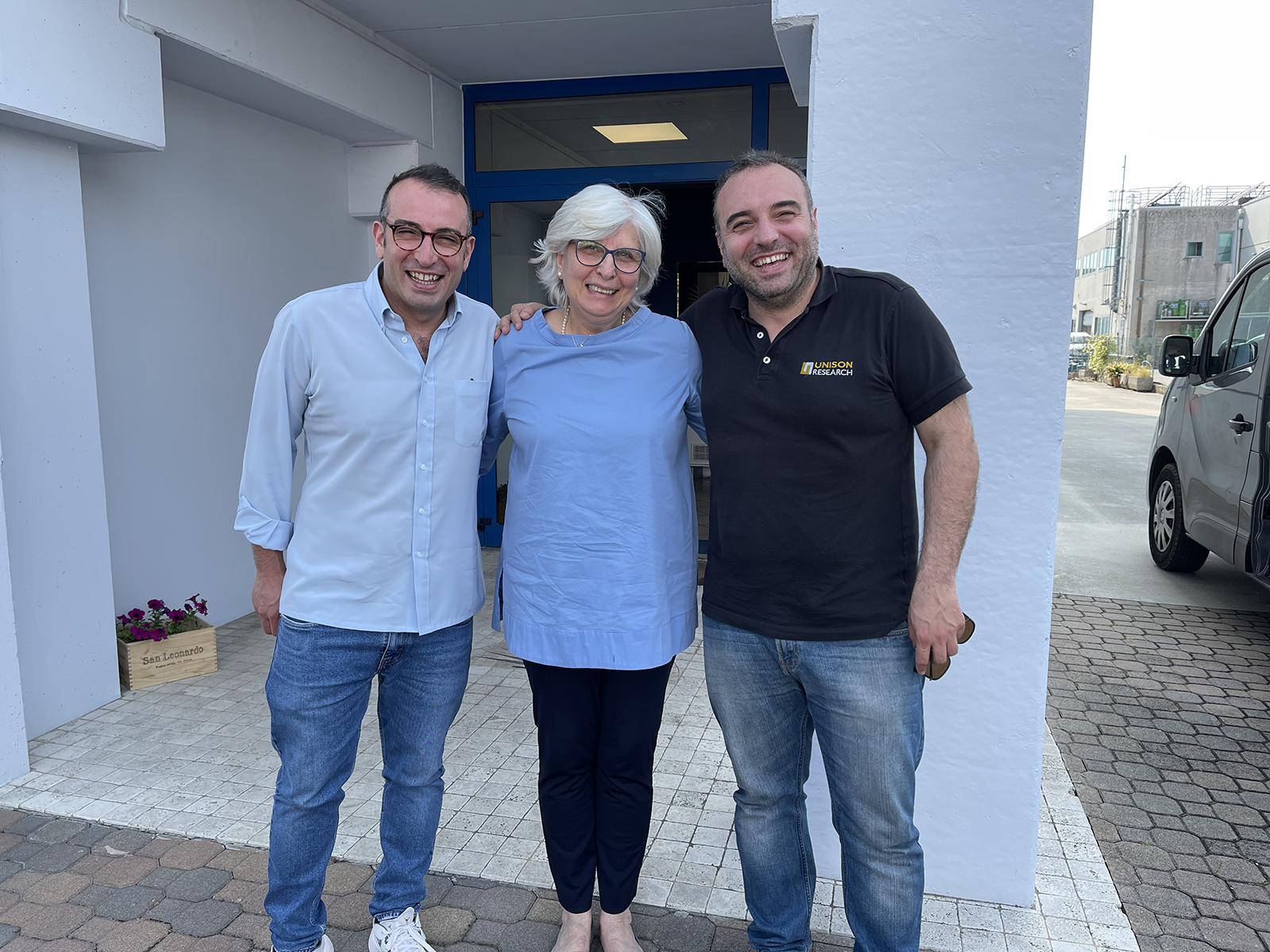After the whirlwind that was the 2023 Munich High-End show, I was invited by US distributor Fidelity Imports on a press tour visiting three of the Italian brands that they represent. This is the first of three articles, each of which will showcase a boutique Italian audio manufacturer. At least, that’s the overarching plan. The interesting thing for me after being a part of this little Italian audio summit was the realization that we have three, functionally and structurally, very different companies here, and yet all three are very much small family-run businesses. And at their absolute core, each shares the same passion to create exquisite audio products that can legitimately stand up against the best out there. And so, we begin our trip with a visit to Unison Research and Opera Loudspeakers.
 The first installment of our junket began on the last day of the Munich High-End show. Steve Jain (Owner and Co-Founder of Fidelity Imports), Bob Weissburg (Fidelity’s Director of Business Development), Mark Eaton (Fidelity Videographer), Jason Thorpe (Reviewer-at-large for Soundstage Network), and yours truly, assembled outside our hotel and made our way to the Munich central train station. We were scheduled to take a roughly 9-hour train ride from Munich, through the Alps, to Venice, and onto our destination, which would be just outside Treviso.
The first installment of our junket began on the last day of the Munich High-End show. Steve Jain (Owner and Co-Founder of Fidelity Imports), Bob Weissburg (Fidelity’s Director of Business Development), Mark Eaton (Fidelity Videographer), Jason Thorpe (Reviewer-at-large for Soundstage Network), and yours truly, assembled outside our hotel and made our way to the Munich central train station. We were scheduled to take a roughly 9-hour train ride from Munich, through the Alps, to Venice, and onto our destination, which would be just outside Treviso.
 Being in Germany one expects a certain efficiency to things. It’s in everything you look at here: that attention to detail, that fastidiousness for quality and Teutonic precision. In sum, German most definitely means quality! Well, the operators of the train we were on apparently didn’t get the memo. We found ourselves in a fully windowed train car with almost no air conditioning for 9 hours in 85+ degree heat, gently basting in our own juices, with Wi-Fi and power services that were sketchy and intermittent at best. Perhaps the train was from the former East Germany, we wondered. No matter though. We had a vital care package from Unison with us consisting of artisanal salami, crostini, bread sticks, a fine bottle of Italian red, a knife, and a cutting board. In the end, that package, the lovely scenery we were passing through, and the most excellent company on this first leg of the trip were more than making up for any inconveniences beyond our control.
Being in Germany one expects a certain efficiency to things. It’s in everything you look at here: that attention to detail, that fastidiousness for quality and Teutonic precision. In sum, German most definitely means quality! Well, the operators of the train we were on apparently didn’t get the memo. We found ourselves in a fully windowed train car with almost no air conditioning for 9 hours in 85+ degree heat, gently basting in our own juices, with Wi-Fi and power services that were sketchy and intermittent at best. Perhaps the train was from the former East Germany, we wondered. No matter though. We had a vital care package from Unison with us consisting of artisanal salami, crostini, bread sticks, a fine bottle of Italian red, a knife, and a cutting board. In the end, that package, the lovely scenery we were passing through, and the most excellent company on this first leg of the trip were more than making up for any inconveniences beyond our control.
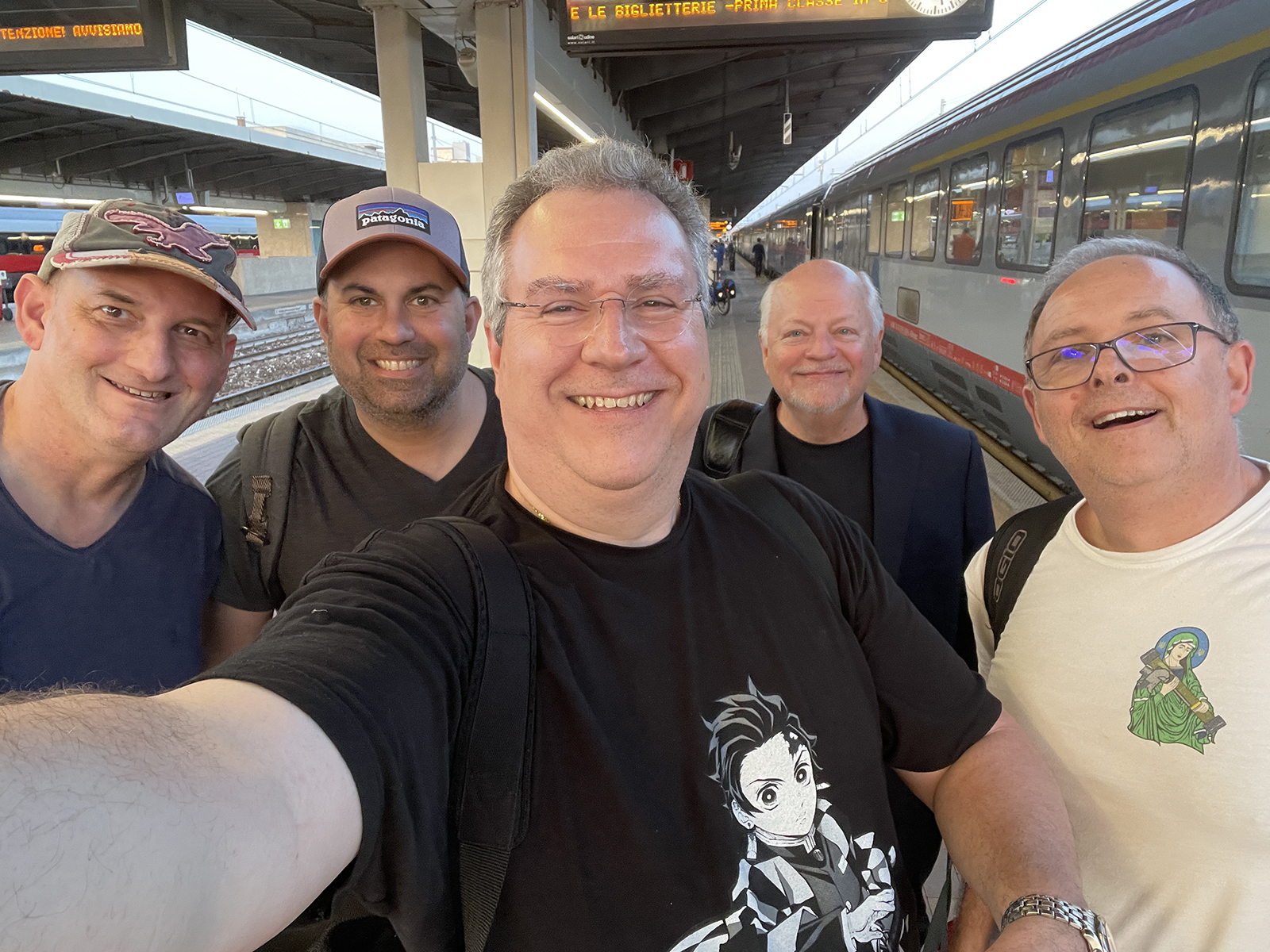 We were an excited, albeit slightly sweaty crew by the time we got to Venice, and finally, Treviso.
We were an excited, albeit slightly sweaty crew by the time we got to Venice, and finally, Treviso.
After we got a chance to get freshened up at our hotel, we reconvened with additional journalists, Julie Mullins and Rogier van Bakel from Stereophile, and Eric Smith from Fidelity Imports. We were also introduced to our Unison Research and Opera Loudspeaker hosts. Brothers Bartolomeo and Riccardo Nasta are the two principals at both companies. Bart and Riccardo’s father, Giovanni Nasta founded Opera Loudspeaker in 1980 with an eye to create hand-crafted Italian loudspeakers of the highest quality and musicality. He eventually purchased an Italian artisanal tube amplifier manufacturer, Unison Research in 1989, and the two brands now function together out of the same headquarters. Giovanni sadly passed on in 2020, and now Bartolomeo and Riccardo, along with their mother Donatella Vigilante, run the operations. Bart oversees the day-to-day operations and management with Riccardo specializing in electronic component control and sourcing for both brands. Very much family, very much Italian.
 So, as we convened that evening at a piazza restaurant over cocktails, charcuterie, and some of the finest pizza that I’ve consumed in a dog’s age, our next two days were outlined for us. Tomorrow we’d be visiting the cabinet manufacturer and woodworkers for Opera and Unison, followed by a tour of the main company facilities and then some listening sessions folded in for good measure. The day after would involve visiting the surface-mounted electronics board assembly facility, and a late goodbye lunch before we continued to our next stop on the junket.
So, as we convened that evening at a piazza restaurant over cocktails, charcuterie, and some of the finest pizza that I’ve consumed in a dog’s age, our next two days were outlined for us. Tomorrow we’d be visiting the cabinet manufacturer and woodworkers for Opera and Unison, followed by a tour of the main company facilities and then some listening sessions folded in for good measure. The day after would involve visiting the surface-mounted electronics board assembly facility, and a late goodbye lunch before we continued to our next stop on the junket.
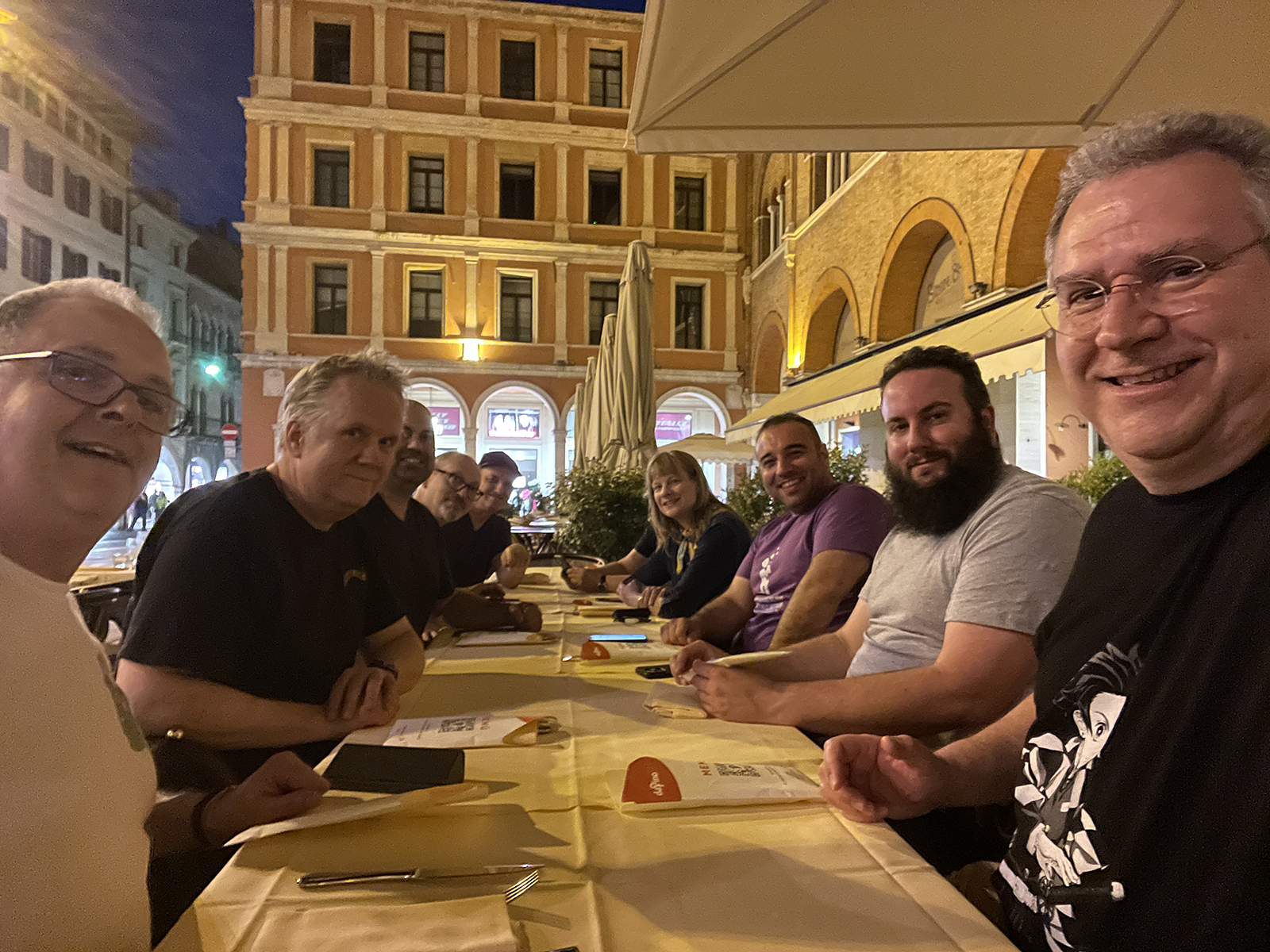 As an aside, you’re going to begin to realize as you read on that much of our discourse, questions, and general understanding of all these companies happens over good food, inspiring surroundings, good humor, and multitudes of espressos and cappuccinos consumed in a day. We started to understand that we had entered a new nexus of time and space which we coined “IST” or “Italian Standard Time.” Everything was done at a different pace. Every activity felt like it was savored, not that it was slow, just more considered. Everything was local. You’ve heard of farm-to-table cooking, well this is farm-to-table audio manufacturing. Local sourcing of almost everything, minimal bureaucracy, and handmade craftsmanship. The process was meant to be enjoyable, even meaningful. And ultimately, while we all came out of this time zone at least 50 pounds heavier when all was said and done, to the person, we came to agree that this seemed a very good way to do business!
As an aside, you’re going to begin to realize as you read on that much of our discourse, questions, and general understanding of all these companies happens over good food, inspiring surroundings, good humor, and multitudes of espressos and cappuccinos consumed in a day. We started to understand that we had entered a new nexus of time and space which we coined “IST” or “Italian Standard Time.” Everything was done at a different pace. Every activity felt like it was savored, not that it was slow, just more considered. Everything was local. You’ve heard of farm-to-table cooking, well this is farm-to-table audio manufacturing. Local sourcing of almost everything, minimal bureaucracy, and handmade craftsmanship. The process was meant to be enjoyable, even meaningful. And ultimately, while we all came out of this time zone at least 50 pounds heavier when all was said and done, to the person, we came to agree that this seemed a very good way to do business!
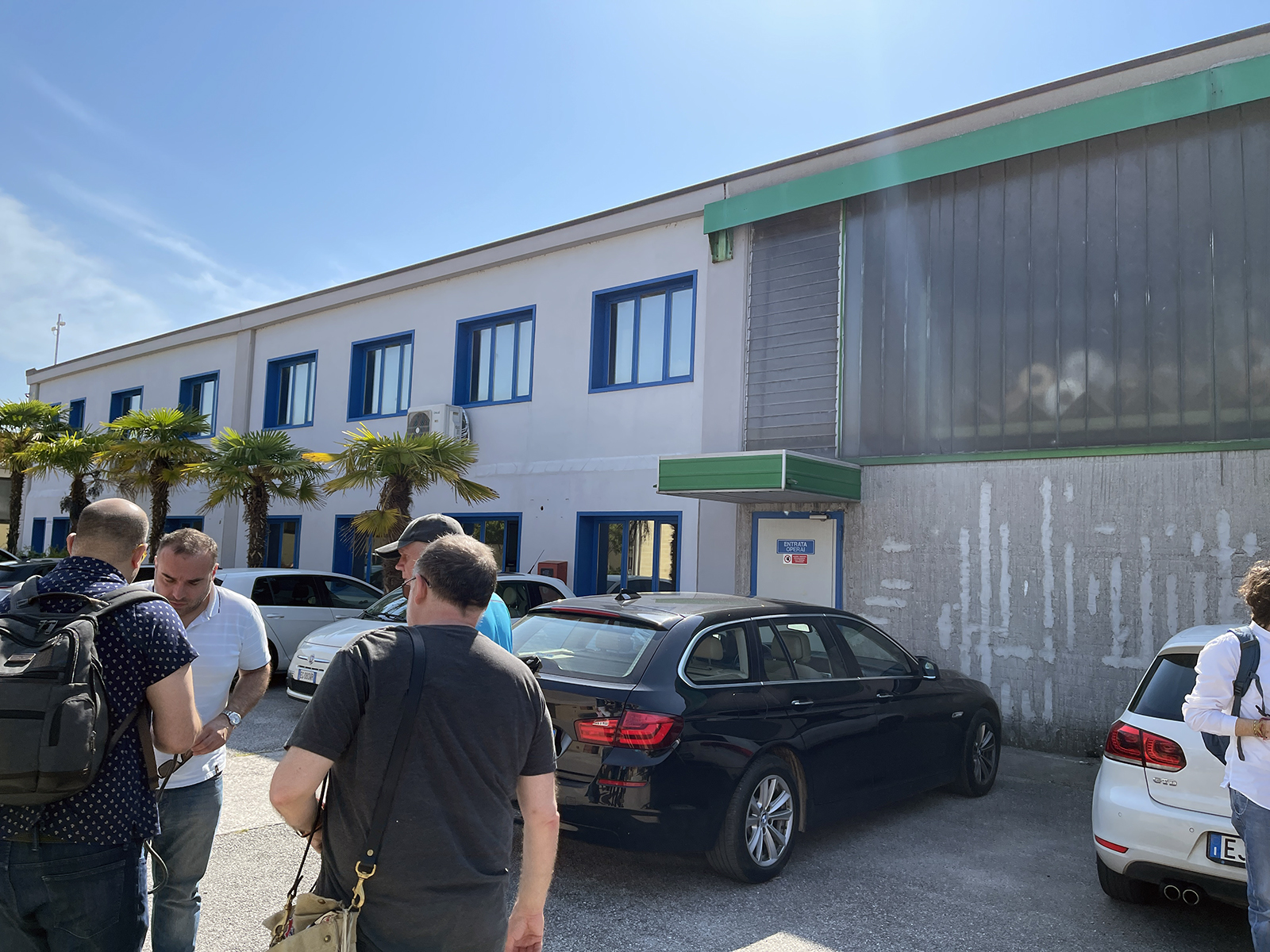 The next morning our intrepid little group piled into a van and made the short drive over to the cabinet and woodworking company Unison and Opera contract with, Arte & Wood. Comprised of two main buildings in a small industrial park, Arte & Wood is owned by Giovanni who has been a woodworker for 50 years and has been operating this shop for 22.
The next morning our intrepid little group piled into a van and made the short drive over to the cabinet and woodworking company Unison and Opera contract with, Arte & Wood. Comprised of two main buildings in a small industrial park, Arte & Wood is owned by Giovanni who has been a woodworker for 50 years and has been operating this shop for 22.
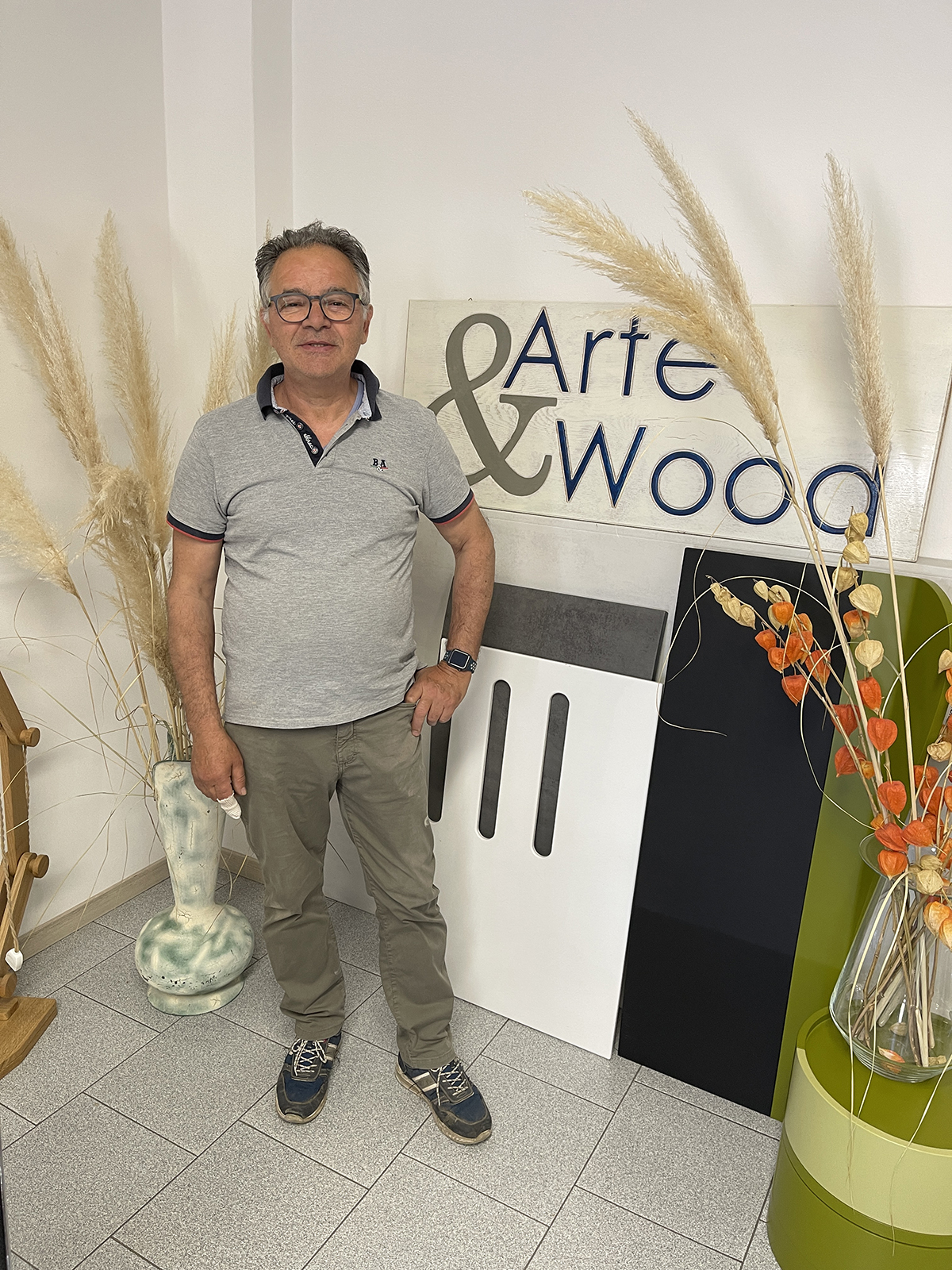 He has 35 skilled workers here and as this is also a family business; both his son and daughter are part of the staff. According to Giovanni, Arte & Wood’s primary business is in fine furniture making for both domestic and export sales. The speaker cabinetry and amplifier trim work comprises about 20% of his day-to-day.
He has 35 skilled workers here and as this is also a family business; both his son and daughter are part of the staff. According to Giovanni, Arte & Wood’s primary business is in fine furniture making for both domestic and export sales. The speaker cabinetry and amplifier trim work comprises about 20% of his day-to-day.
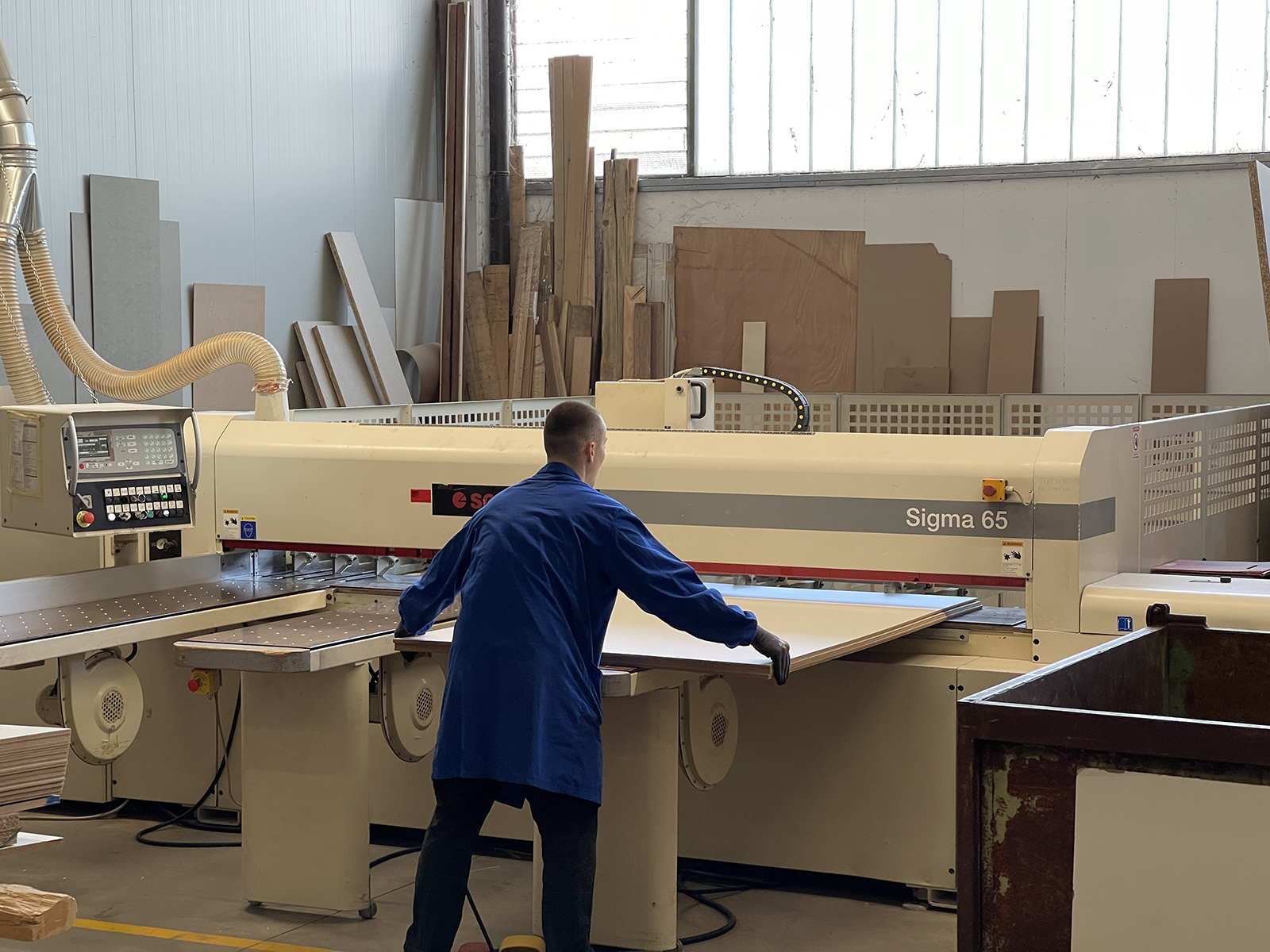
 As we begin walking the production floor taking note of the multiple CNC machines, speaker cabinet forms, and presses, we start getting a deep dive into the cabinet production process for Opera’s Callas and Grand Callas loudspeakers.
As we begin walking the production floor taking note of the multiple CNC machines, speaker cabinet forms, and presses, we start getting a deep dive into the cabinet production process for Opera’s Callas and Grand Callas loudspeakers.

 It’s a system that involves forming multiple layers of ply at just the right curvatures so that they can be stacked, bonded, pressed, and cured into impressively dense, and rigid paneling. There are dozens of massive custom-made forms and jigs in this facility, all made to bend and shape layers of wood to whatever radius is required.
It’s a system that involves forming multiple layers of ply at just the right curvatures so that they can be stacked, bonded, pressed, and cured into impressively dense, and rigid paneling. There are dozens of massive custom-made forms and jigs in this facility, all made to bend and shape layers of wood to whatever radius is required.

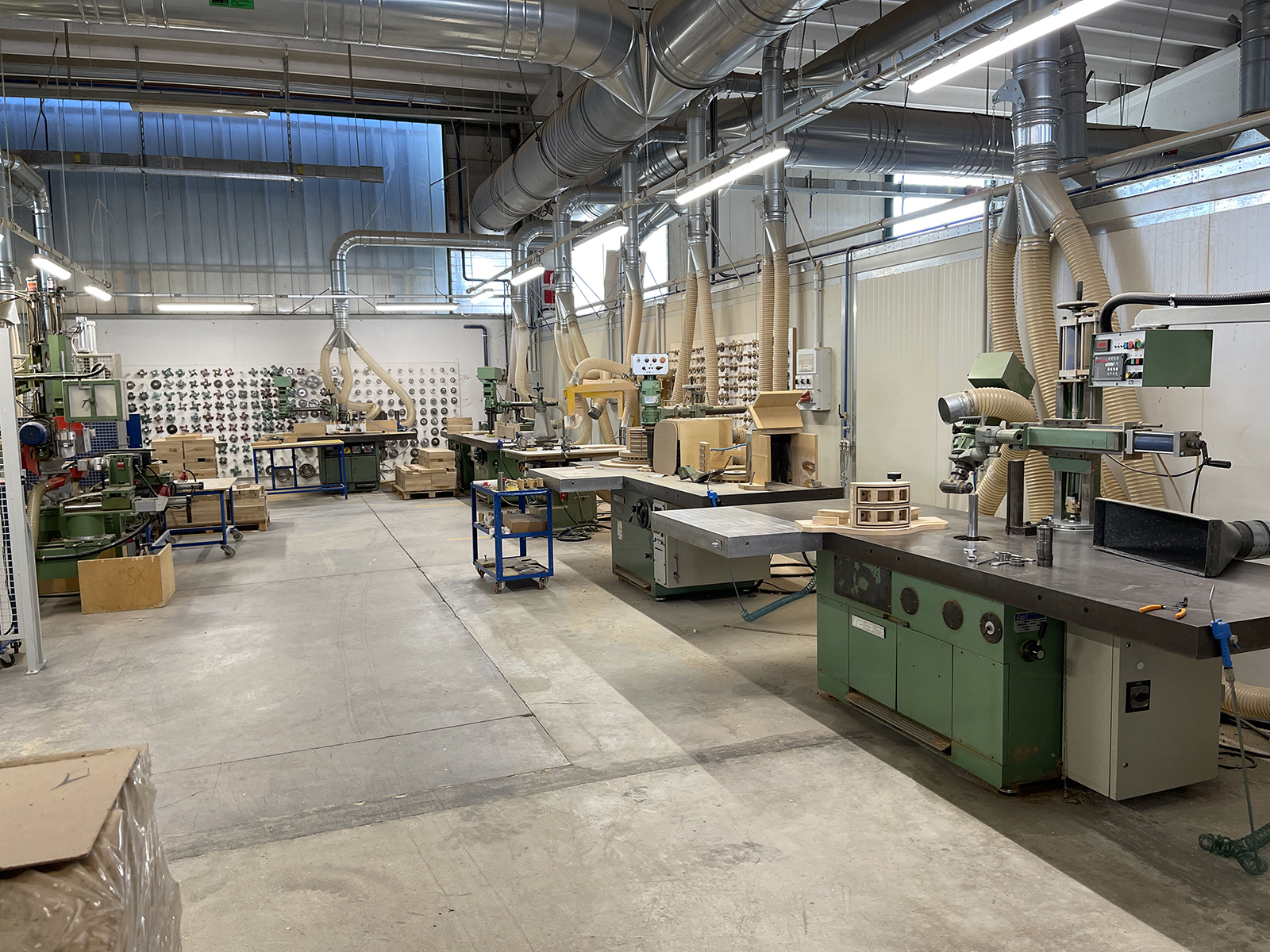 It’s clear that Bart and Riccardo both rely on Giovanni’s expertise and advice as to what can and can’t be done with wood in order to implement their ideas effectively.
It’s clear that Bart and Riccardo both rely on Giovanni’s expertise and advice as to what can and can’t be done with wood in order to implement their ideas effectively.
We soon moved from this cutting and forming area of the shop into a separate building that is solely reserved for loudspeaker cabinet assembly and finishing.
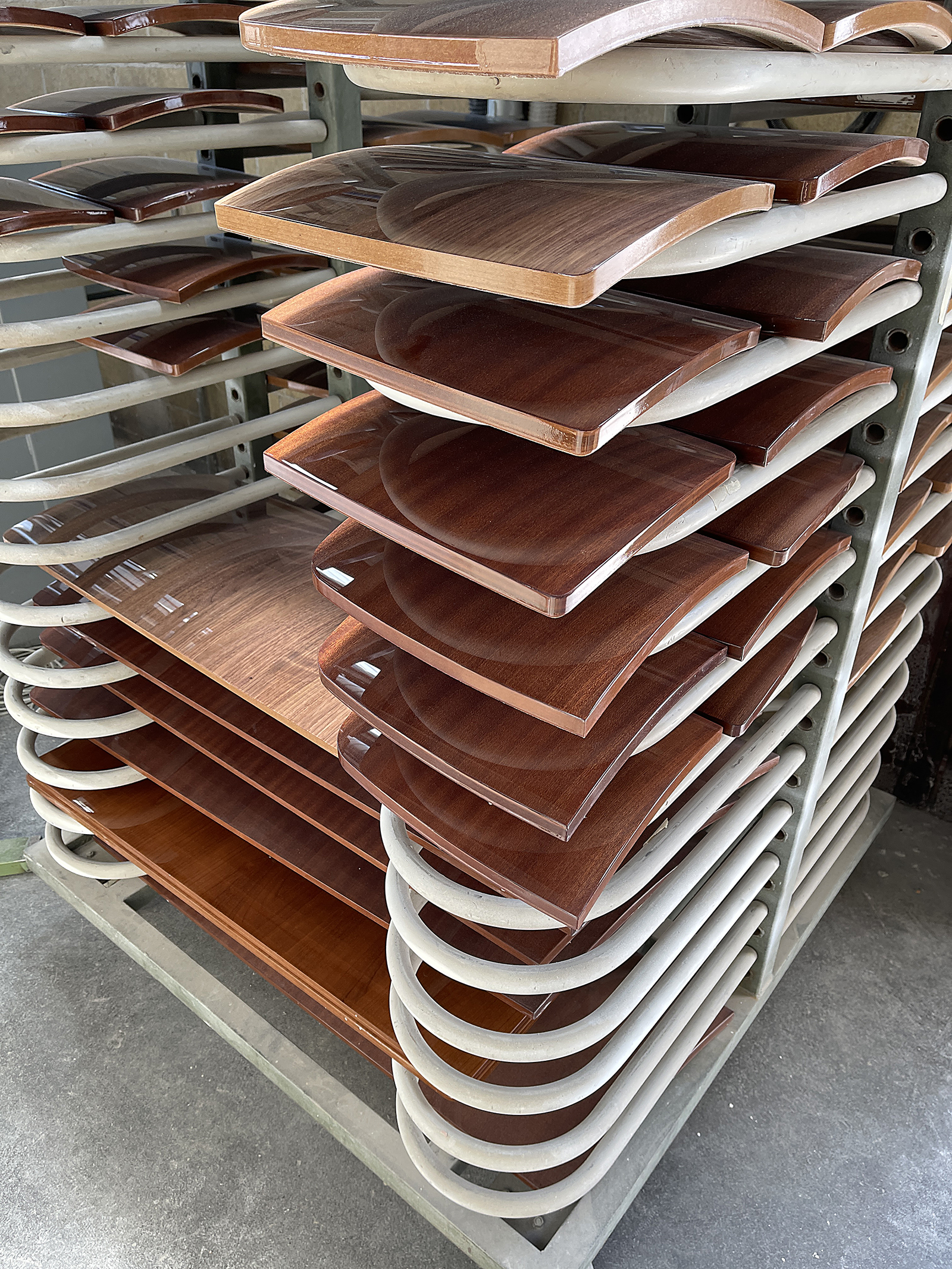
 Here we see everything from the gluing of enclosures to lacquering and polishing of fine finishes, the stretching and application of leather, and so on. Minimal automation is found here. This is the repository of hand craftsmen taking the “raw ore” from the shop area and refining that into the finished “gems” that we see and eventually hear. Giovanni informs us that it takes 90 days for a single model run of 50 speakers to be completed in his facility.
Here we see everything from the gluing of enclosures to lacquering and polishing of fine finishes, the stretching and application of leather, and so on. Minimal automation is found here. This is the repository of hand craftsmen taking the “raw ore” from the shop area and refining that into the finished “gems” that we see and eventually hear. Giovanni informs us that it takes 90 days for a single model run of 50 speakers to be completed in his facility.
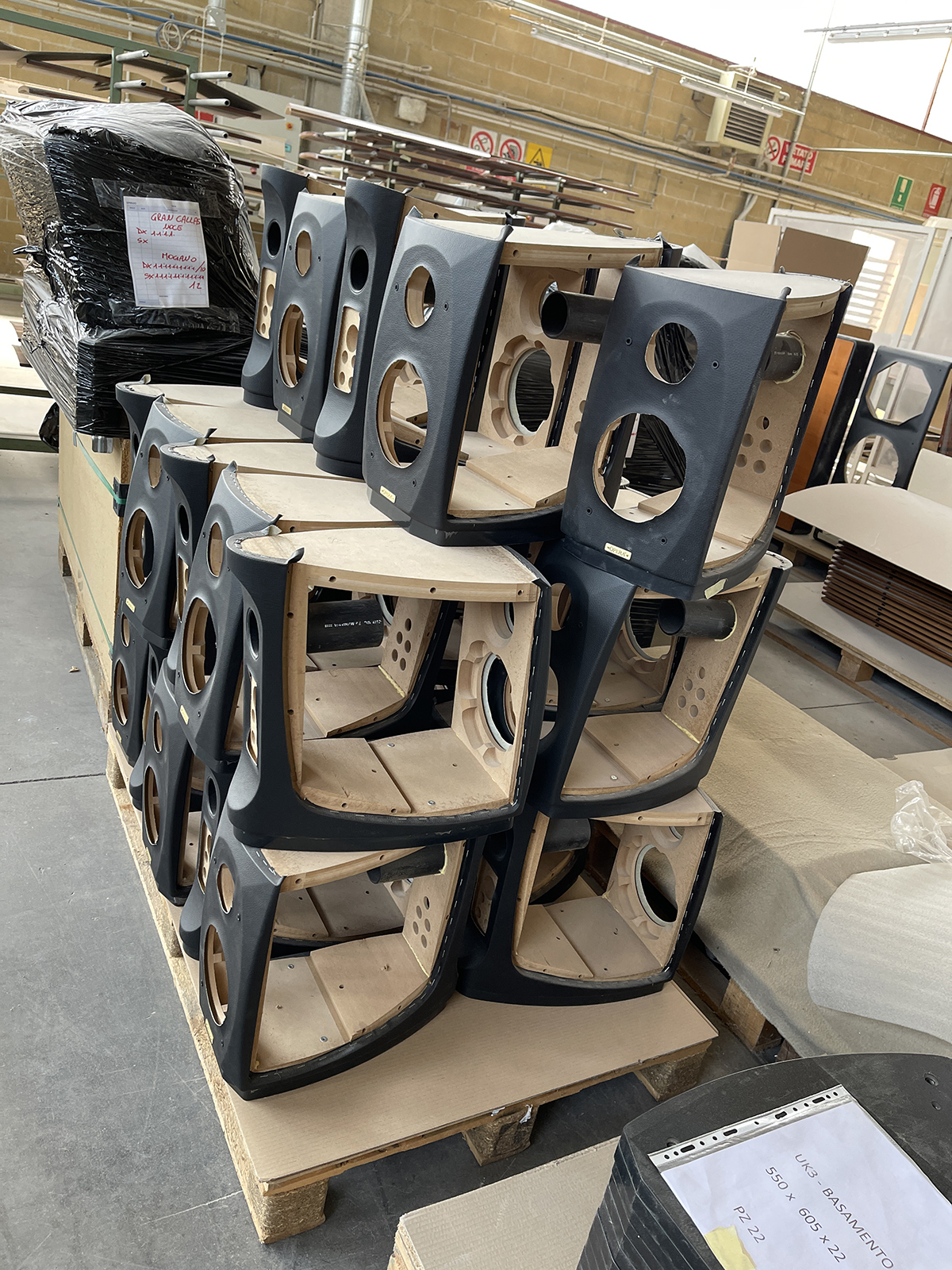
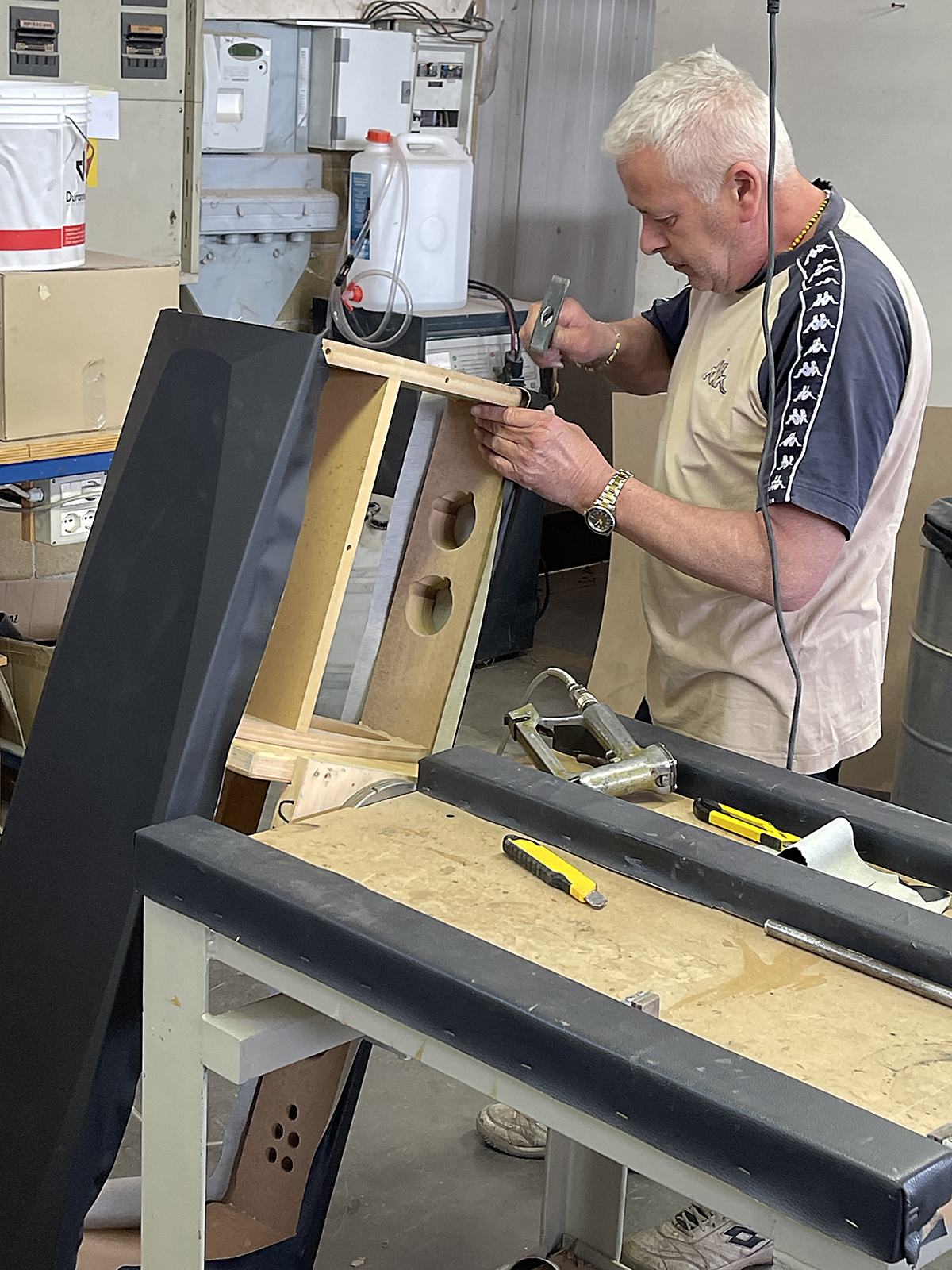 The 5-stage lacquering and polishing process alone takes 3 days to complete. I asked Giovanni about what the typical rejection rate or defect ratio in production is. He responds that they can keep defects down to a bare minimum due to QC checks at every stage of production.
The 5-stage lacquering and polishing process alone takes 3 days to complete. I asked Giovanni about what the typical rejection rate or defect ratio in production is. He responds that they can keep defects down to a bare minimum due to QC checks at every stage of production.
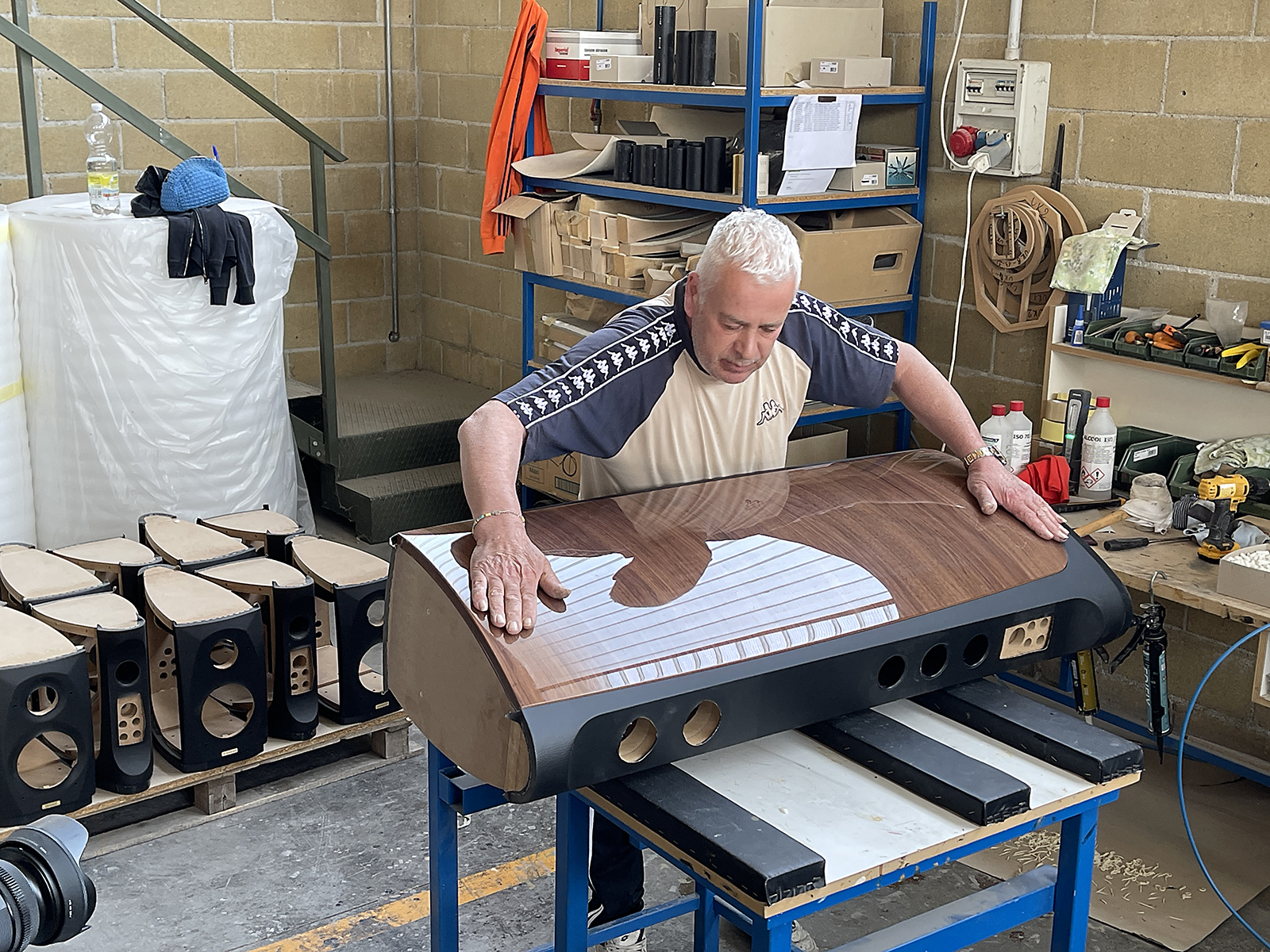
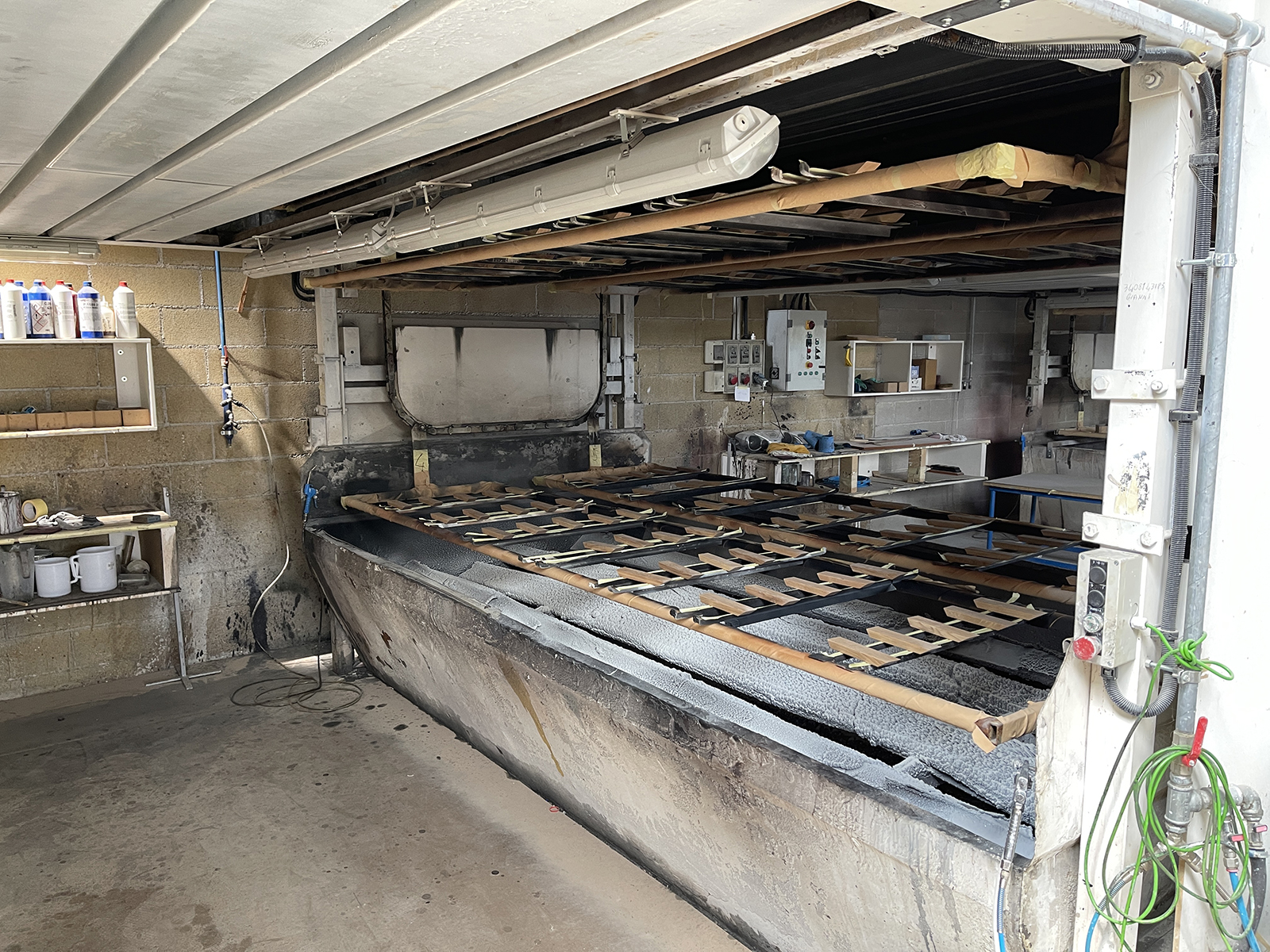 He also states a common problem that seems to plague Italian manufacturing as much as we hear it does in US manufacturing. That is the teaching and training of craftsmen to carry on and excel at this kind of work. An apprentice must spend about 5 years at a particular stage of production to begin mastering that step.
He also states a common problem that seems to plague Italian manufacturing as much as we hear it does in US manufacturing. That is the teaching and training of craftsmen to carry on and excel at this kind of work. An apprentice must spend about 5 years at a particular stage of production to begin mastering that step.
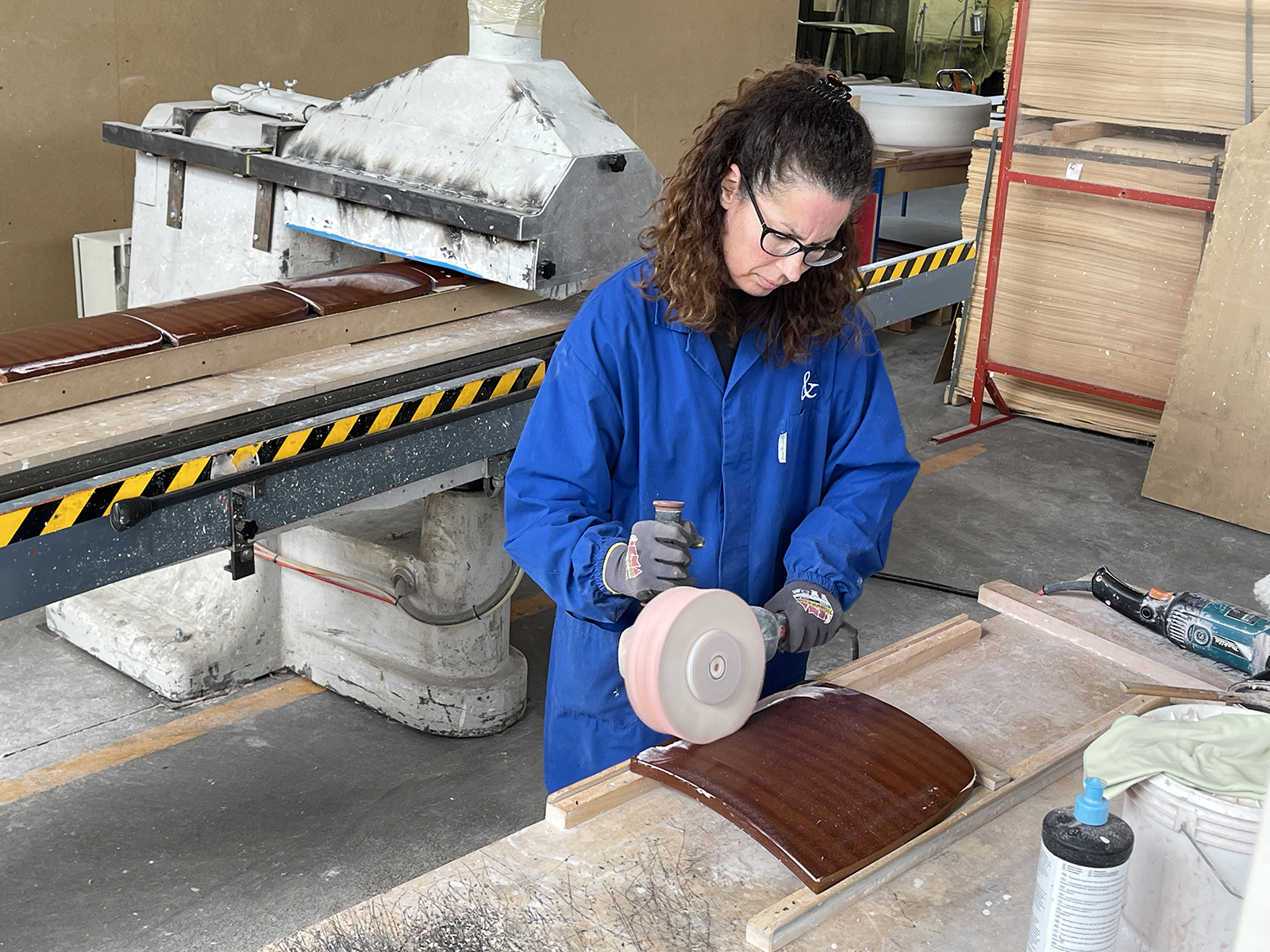
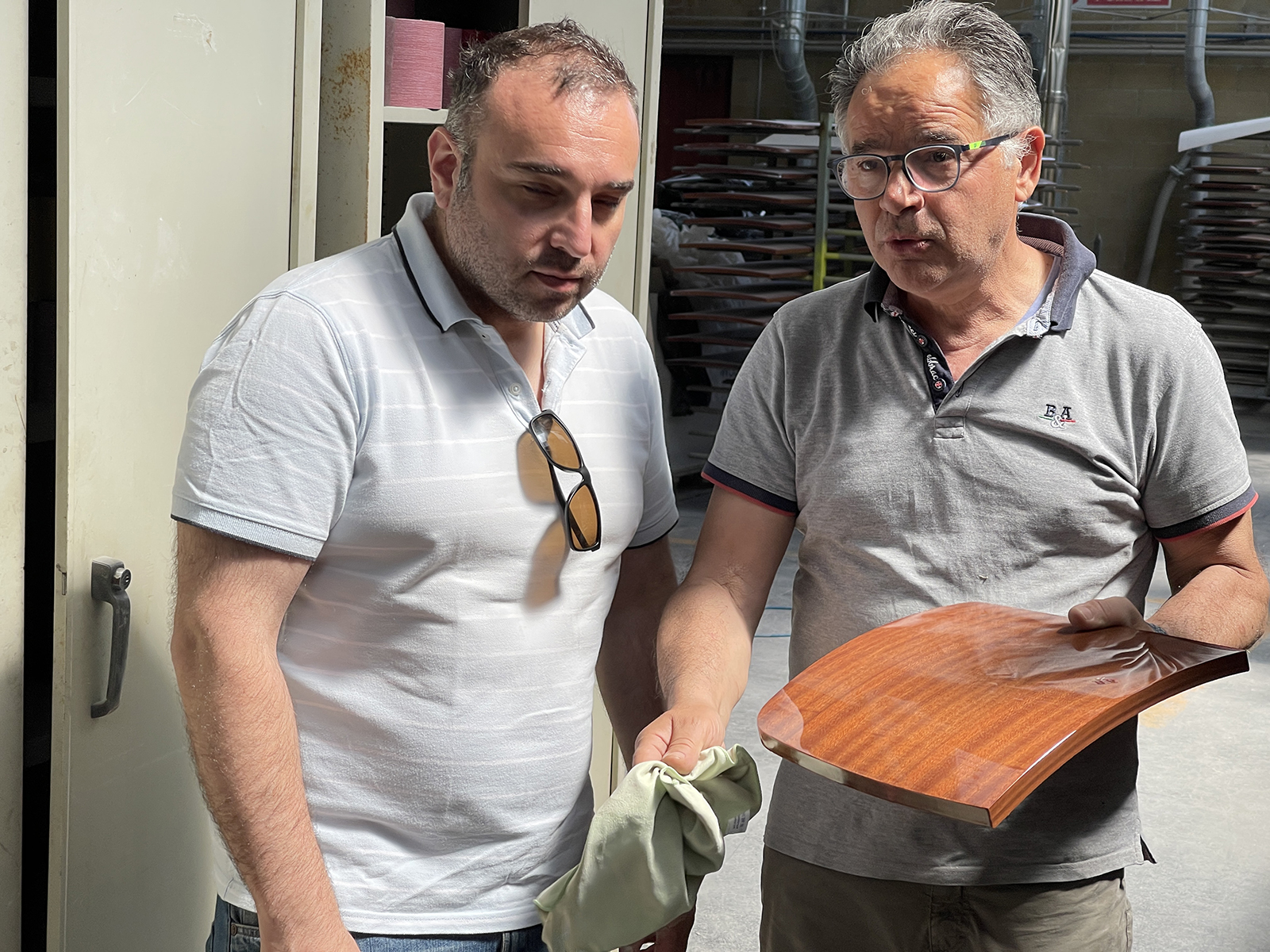 It’s physical, painstaking work, but when you see and eventually experience the finished results you cannot help but be impressed.
It’s physical, painstaking work, but when you see and eventually experience the finished results you cannot help but be impressed.
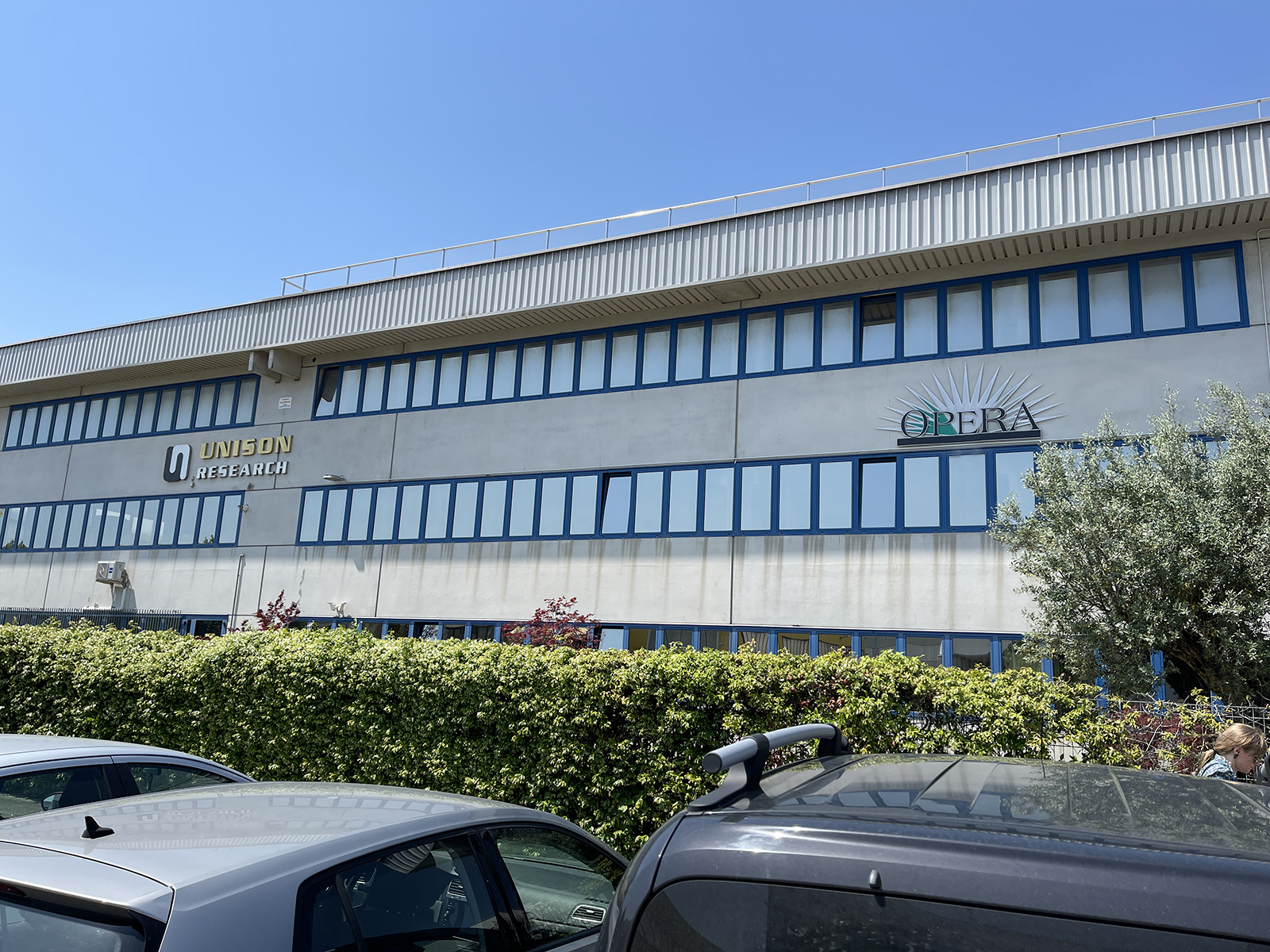 After saying our goodbyes to Giovanni, we piled back in the van and made our way to Unison/Opera HQ, a sizable three-story building located a short distance away in another industrial park. Once through the lobby, we entered a large staging area where several pallets of loudspeakers were either ready to have their drivers loaded or were going through final checks in preparation for shipping.
After saying our goodbyes to Giovanni, we piled back in the van and made our way to Unison/Opera HQ, a sizable three-story building located a short distance away in another industrial park. Once through the lobby, we entered a large staging area where several pallets of loudspeakers were either ready to have their drivers loaded or were going through final checks in preparation for shipping.
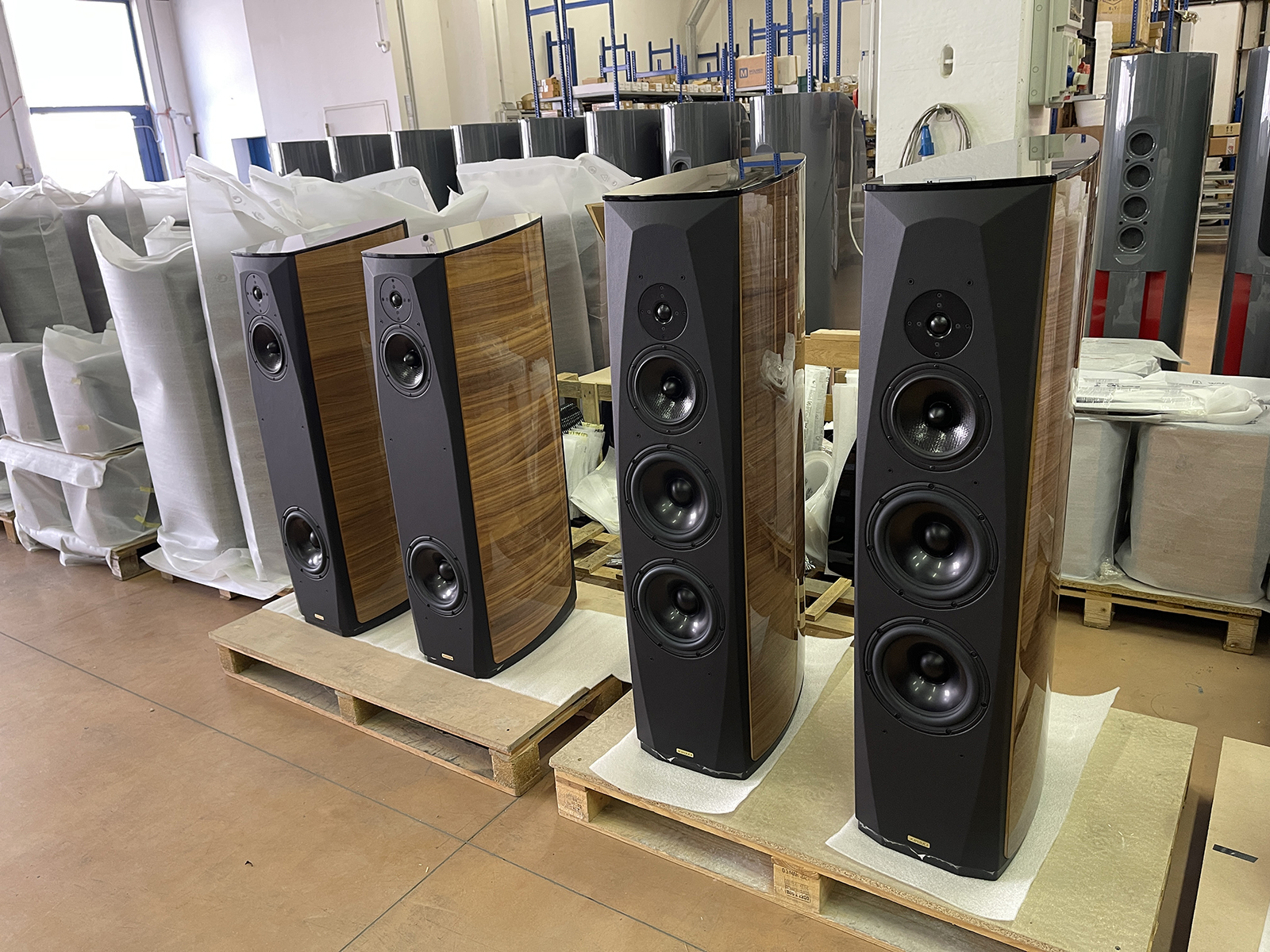
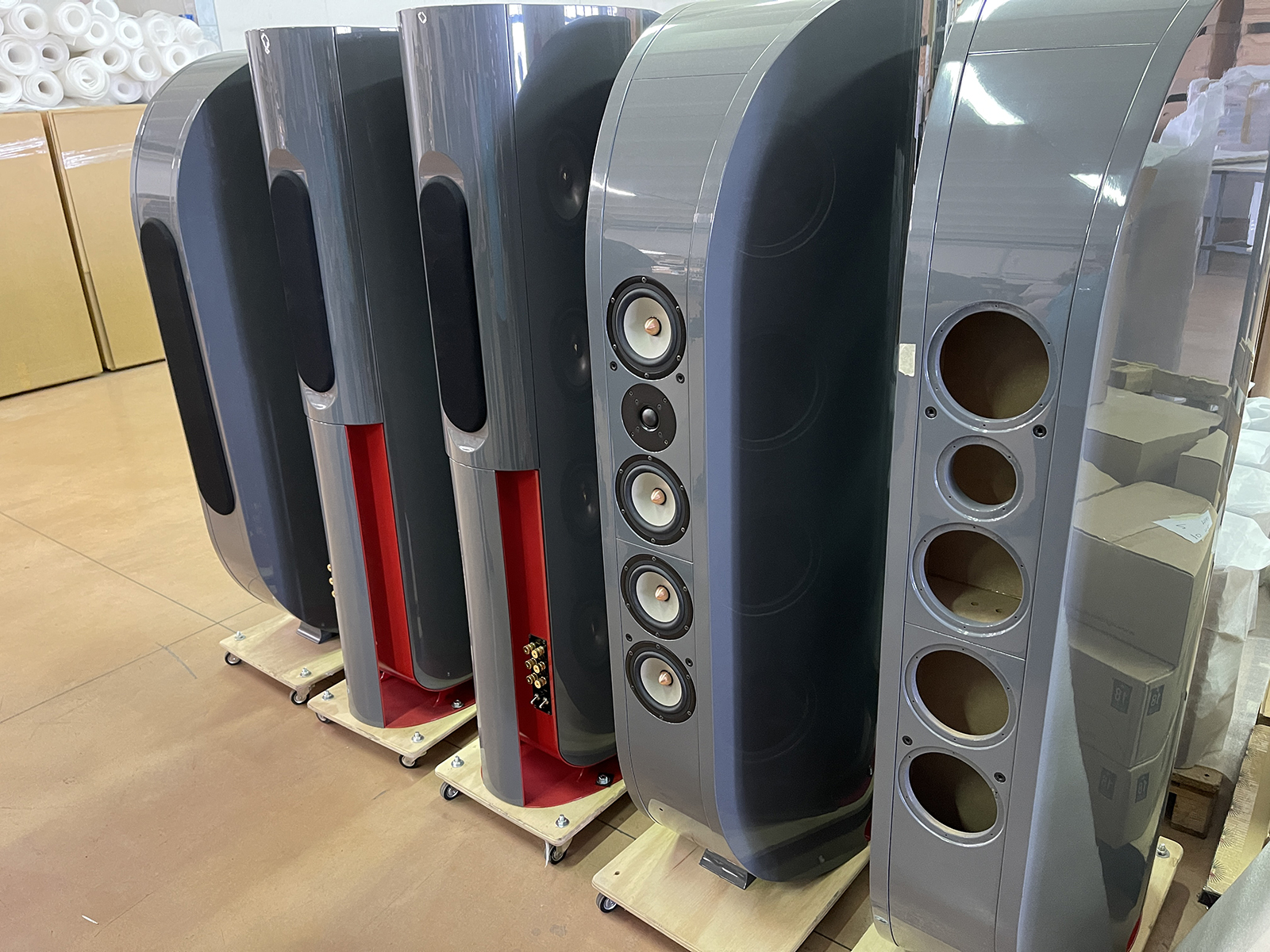
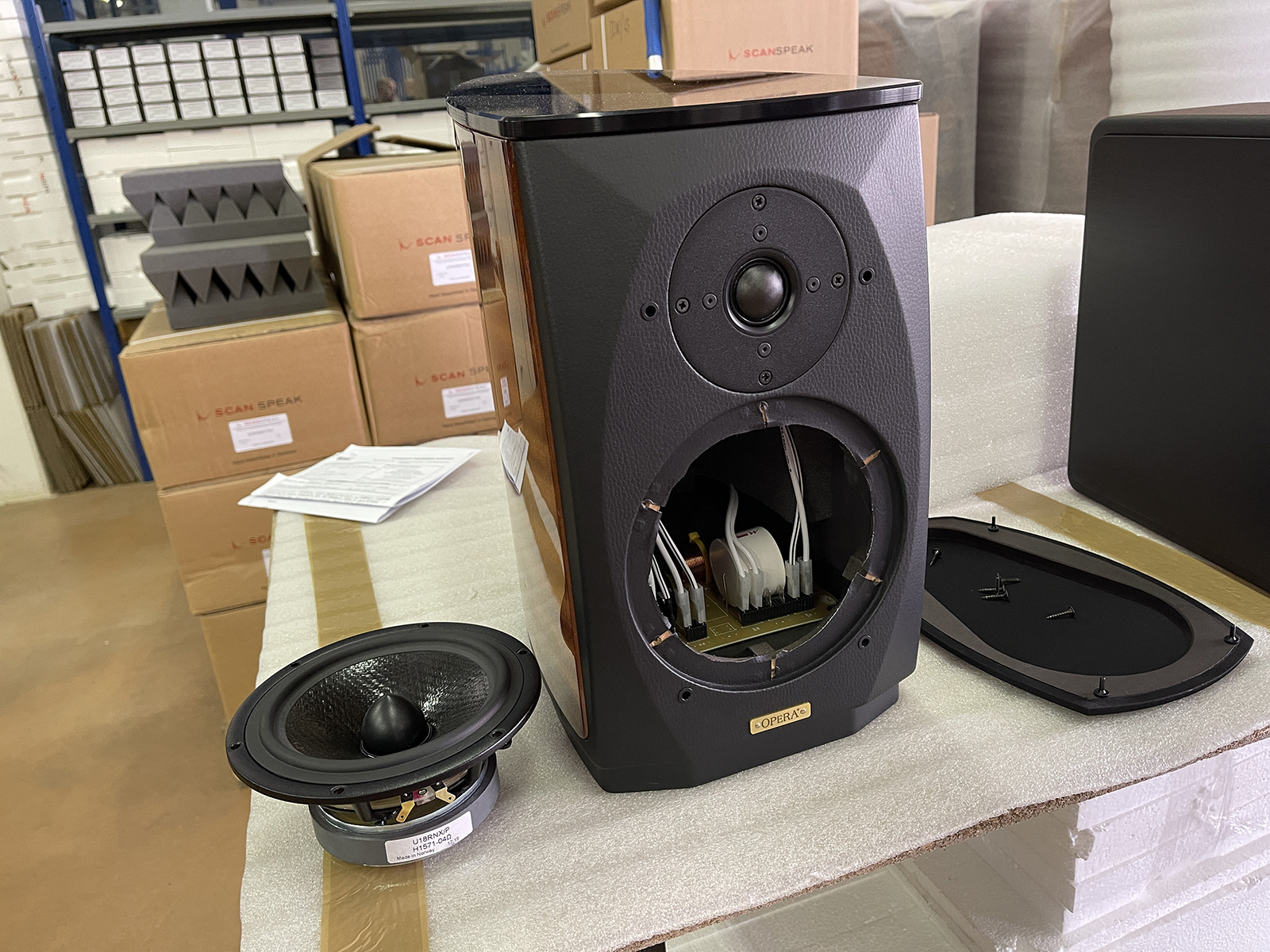 I spied several beautiful examples of the Callas, and Grand Callas loudspeakers, along with a few models that I was unfamiliar with, finished in competition grey and red automotive paintwork. Then I caught glimpses of two high-efficiency speaker designs under the Unison brand.
I spied several beautiful examples of the Callas, and Grand Callas loudspeakers, along with a few models that I was unfamiliar with, finished in competition grey and red automotive paintwork. Then I caught glimpses of two high-efficiency speaker designs under the Unison brand.

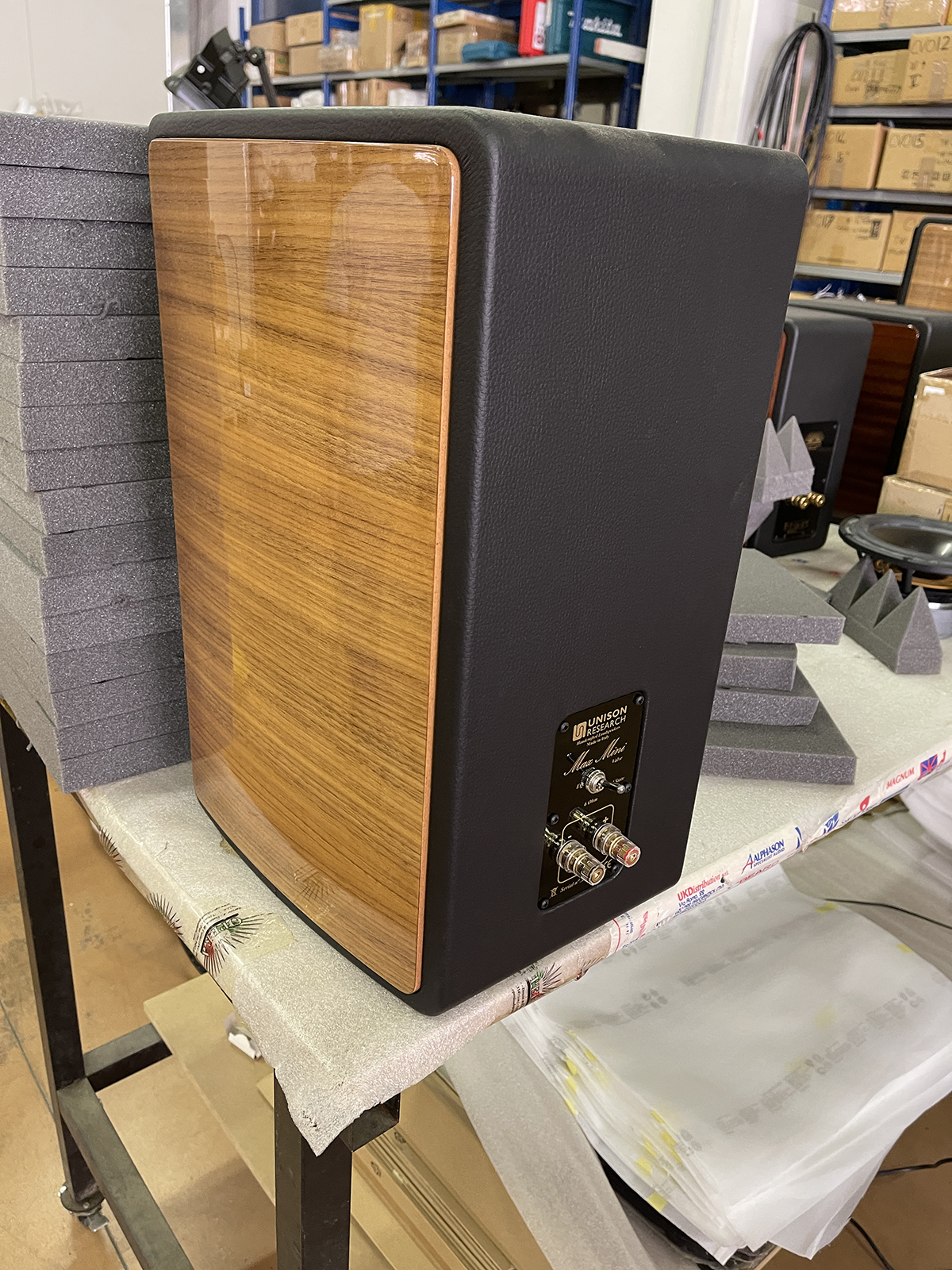 The Max Mini and Max II are both two-way speakers with horn-loaded compression drivers. The Max II floor-stander specifically got my juices going with its 1.4” compression driver mated to a 15” pro woofer, all in a beautiful hand-finished wood and leather enclosure ($13K per pair). Classic, full shapes, and clean lines are a common design thread among all the speakers we see here. Everything looks and feels substantial.
The Max Mini and Max II are both two-way speakers with horn-loaded compression drivers. The Max II floor-stander specifically got my juices going with its 1.4” compression driver mated to a 15” pro woofer, all in a beautiful hand-finished wood and leather enclosure ($13K per pair). Classic, full shapes, and clean lines are a common design thread among all the speakers we see here. Everything looks and feels substantial.
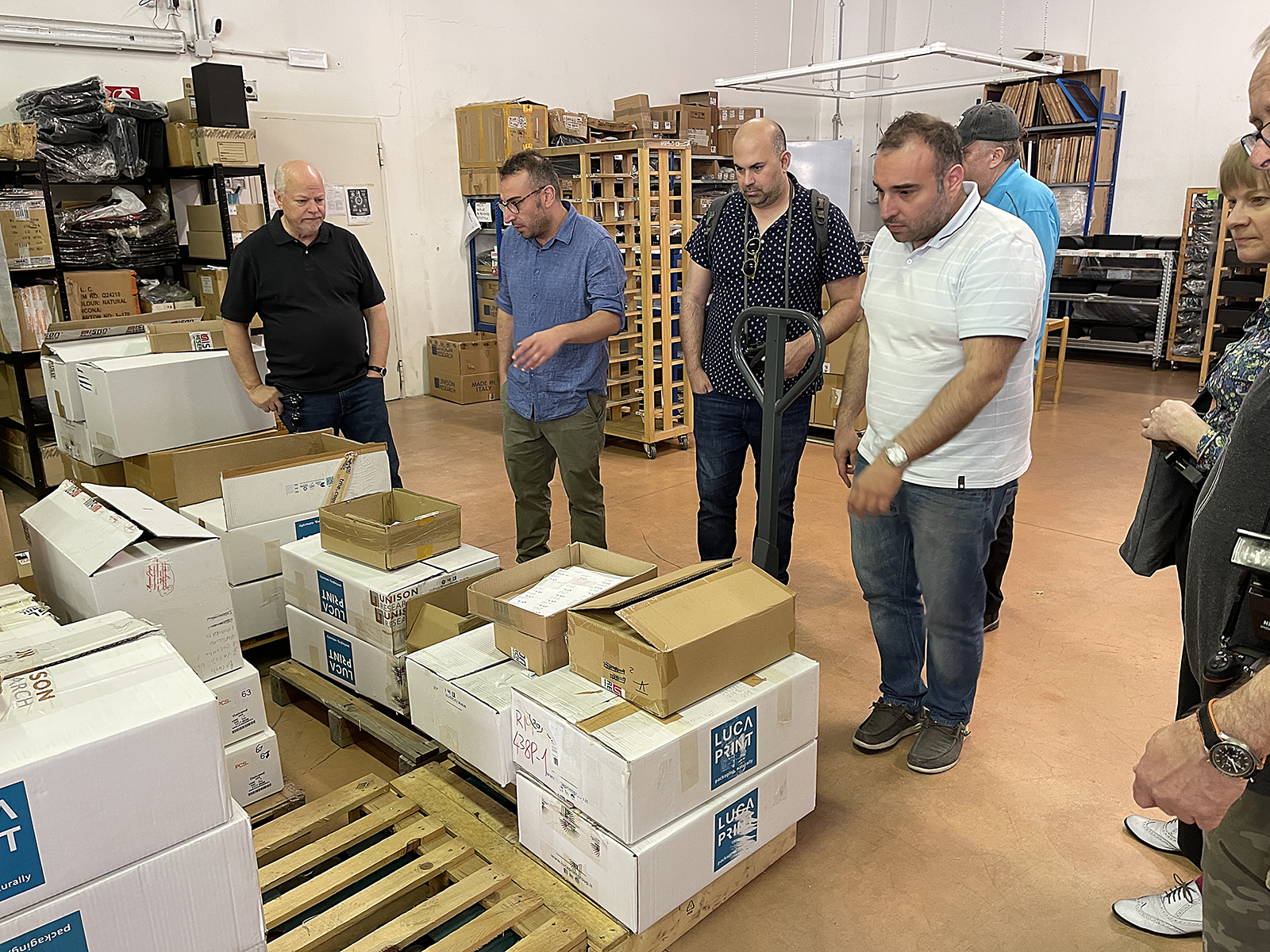
 We continued through the parts supply and completed stock areas of the building, along with the silk screening stations where all logos and text are printed onto electronics casings in-house. Again, both Bart and Riccardo reiterated to us how, except for speaker binding posts, some aluminum panels, and vacuum tubes, all parts and components for both the loudspeakers and electronics are sourced locally.
We continued through the parts supply and completed stock areas of the building, along with the silk screening stations where all logos and text are printed onto electronics casings in-house. Again, both Bart and Riccardo reiterated to us how, except for speaker binding posts, some aluminum panels, and vacuum tubes, all parts and components for both the loudspeakers and electronics are sourced locally.
 Most parts come from Italy proper, and then Europe next. A similar mindset I experienced when I visited both DALI in Denmark and Sonus faber as well.
Most parts come from Italy proper, and then Europe next. A similar mindset I experienced when I visited both DALI in Denmark and Sonus faber as well.
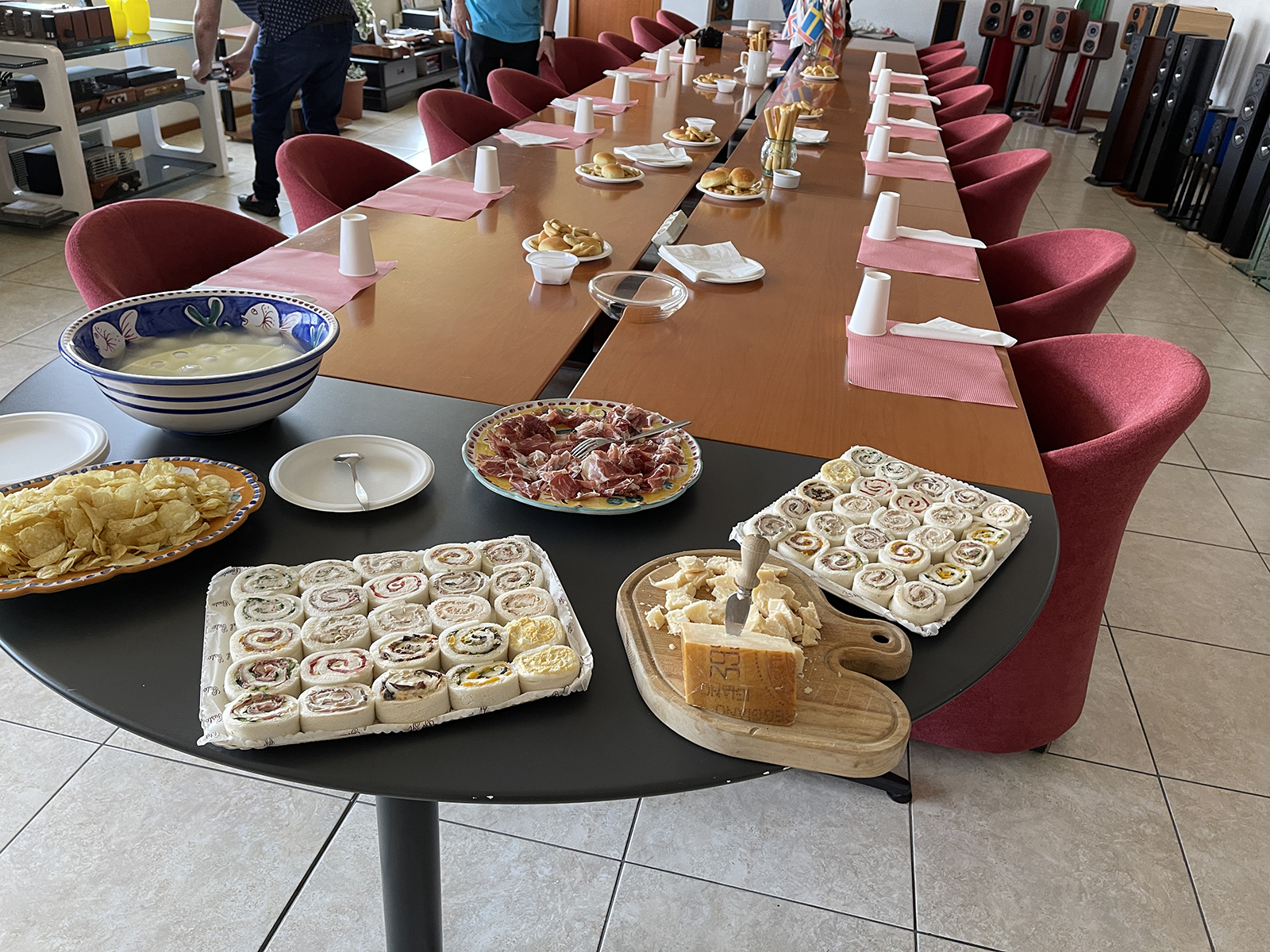 It was at this point that we suddenly slid into “Italian Standard Time” again and with that, were treated to a lovely repast of homemade pinwheel Italian sandwiches, locally made mozzarella, prosciutto, bread, an imposing wedge of Parmigiano Reggiano, pickled peppers, fennel, and olives, along with a fine selection of wines picked by Bartolomeo whose knowledge of all things “vino” borders on the encyclopedic!
It was at this point that we suddenly slid into “Italian Standard Time” again and with that, were treated to a lovely repast of homemade pinwheel Italian sandwiches, locally made mozzarella, prosciutto, bread, an imposing wedge of Parmigiano Reggiano, pickled peppers, fennel, and olives, along with a fine selection of wines picked by Bartolomeo whose knowledge of all things “vino” borders on the encyclopedic!
After the last post-lunch espresso was downed, we proceeded to the electronics manufacturing and assembly area.
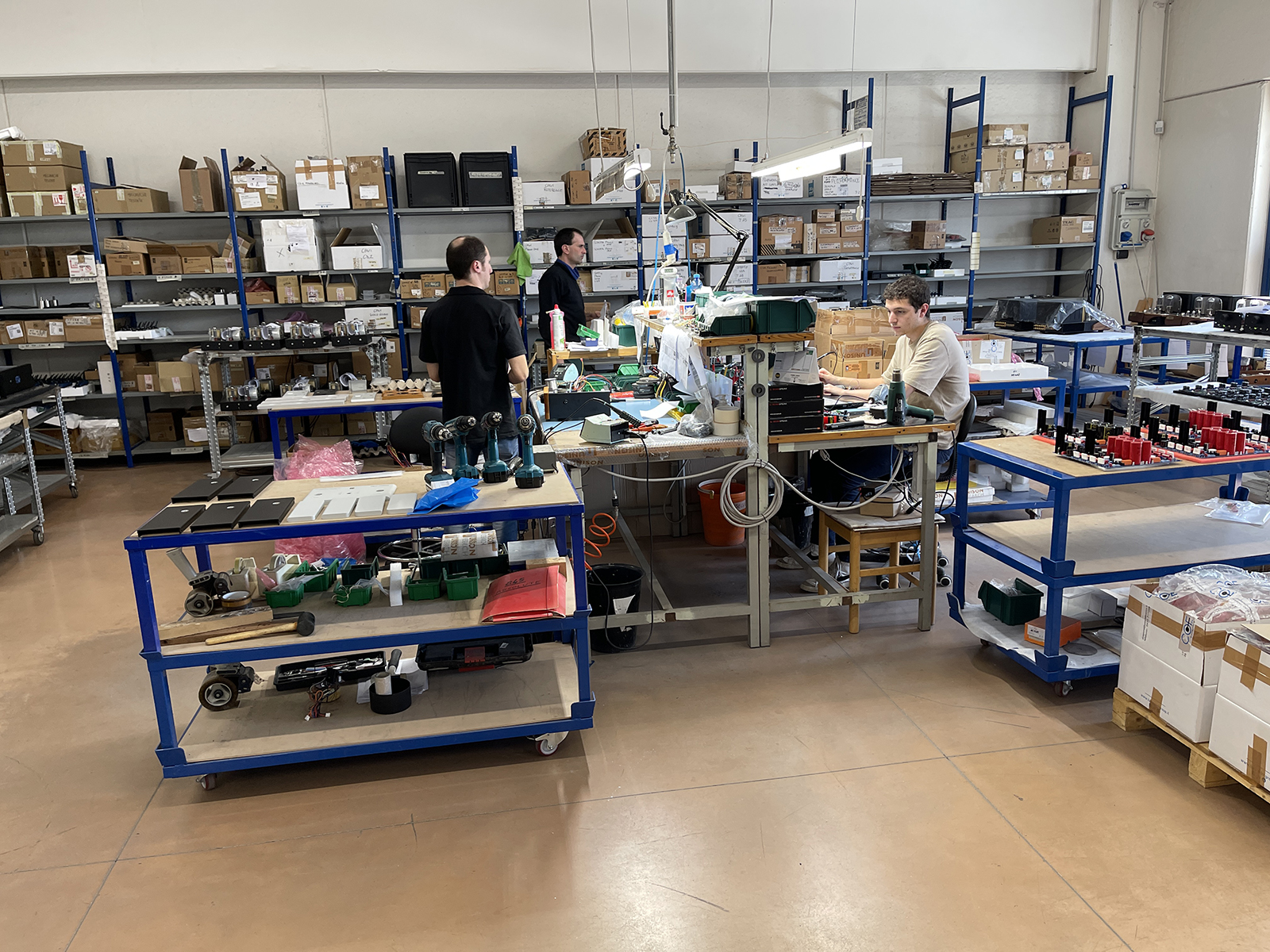 Here we saw examples of every hybrid or valve product Unison Research makes in various stages of production.
Here we saw examples of every hybrid or valve product Unison Research makes in various stages of production.
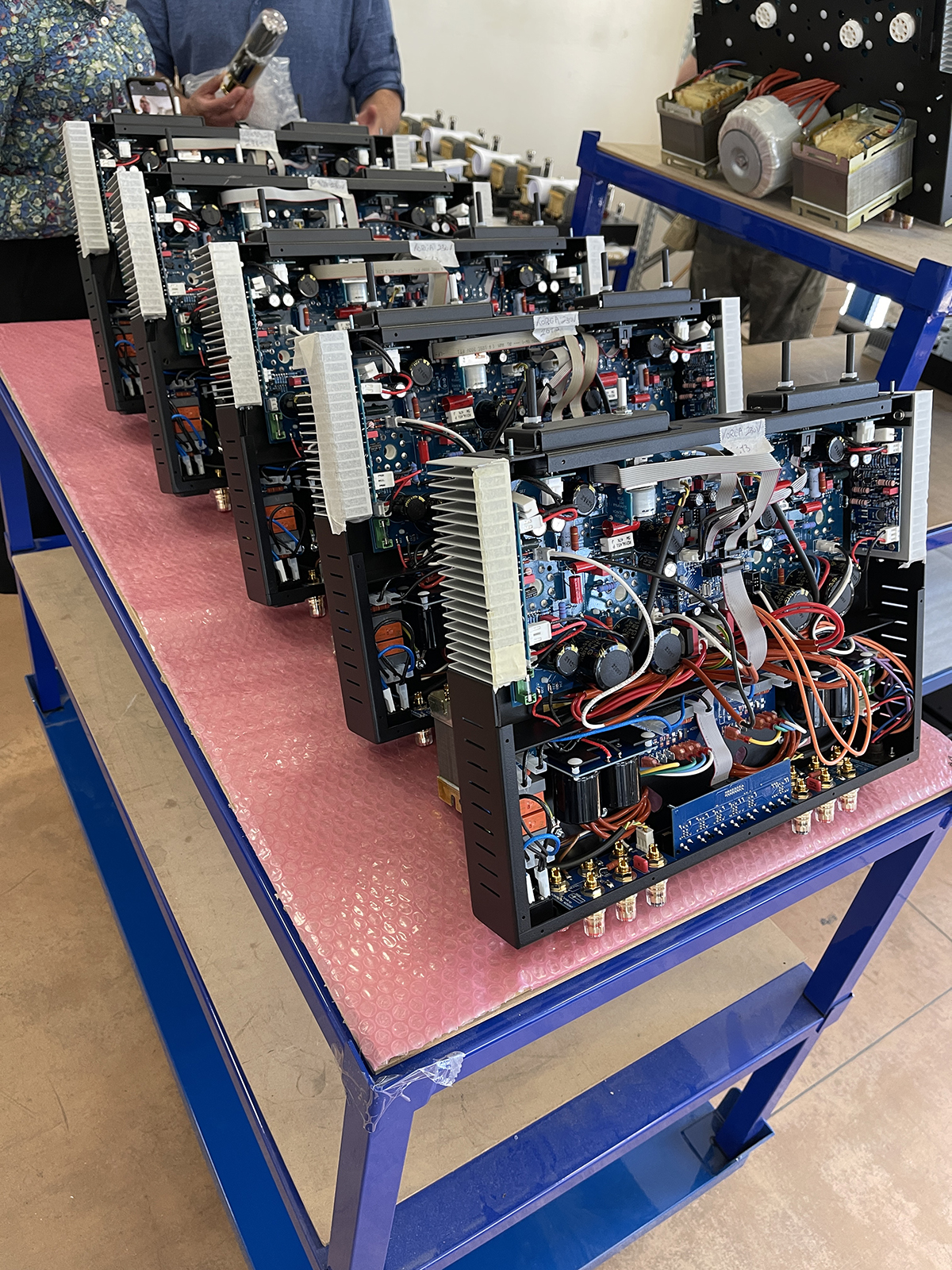
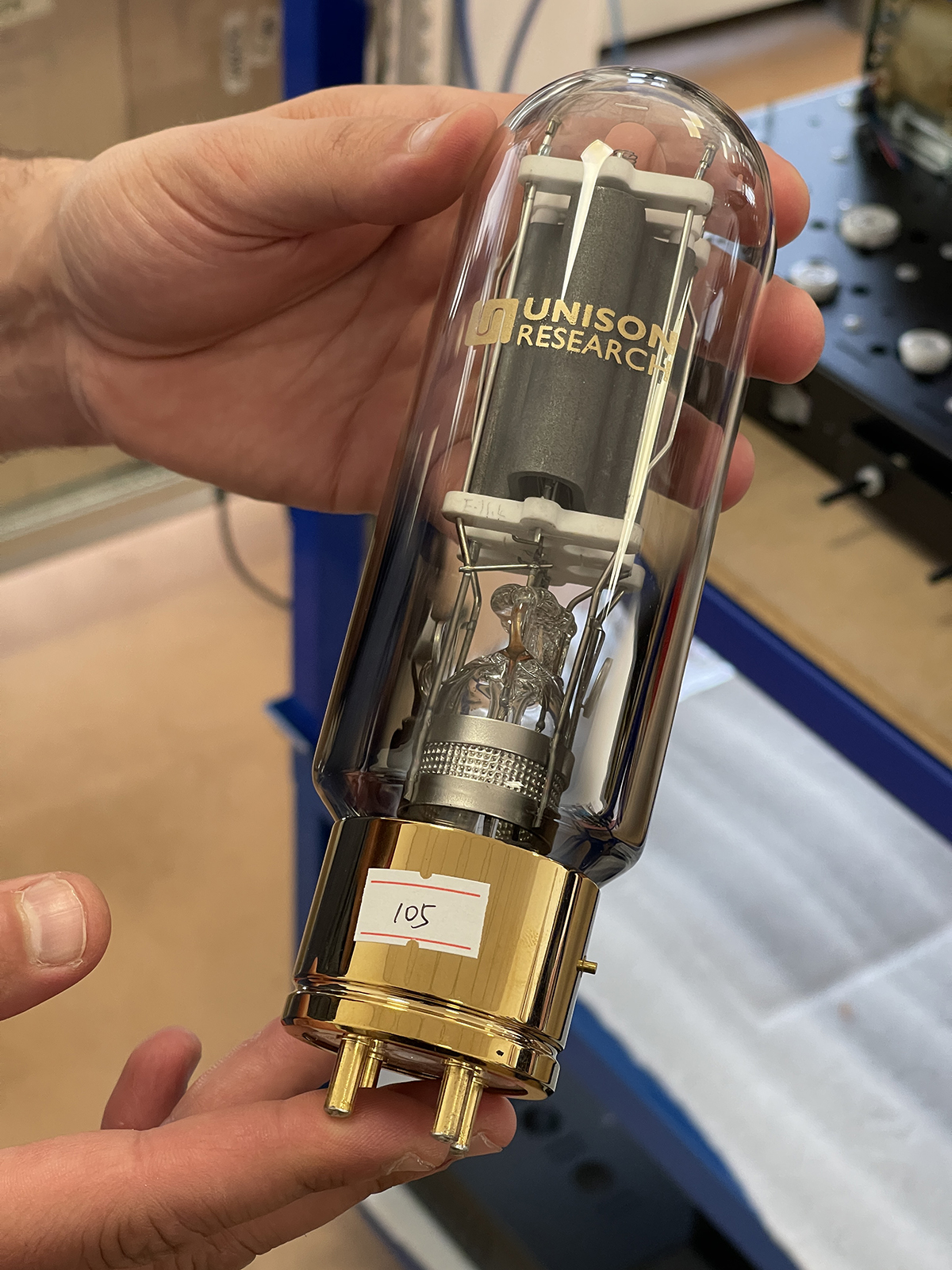 Every assembly and test station was neat and orderly with an identical mindset extending into the internal construction of each component.
Every assembly and test station was neat and orderly with an identical mindset extending into the internal construction of each component.
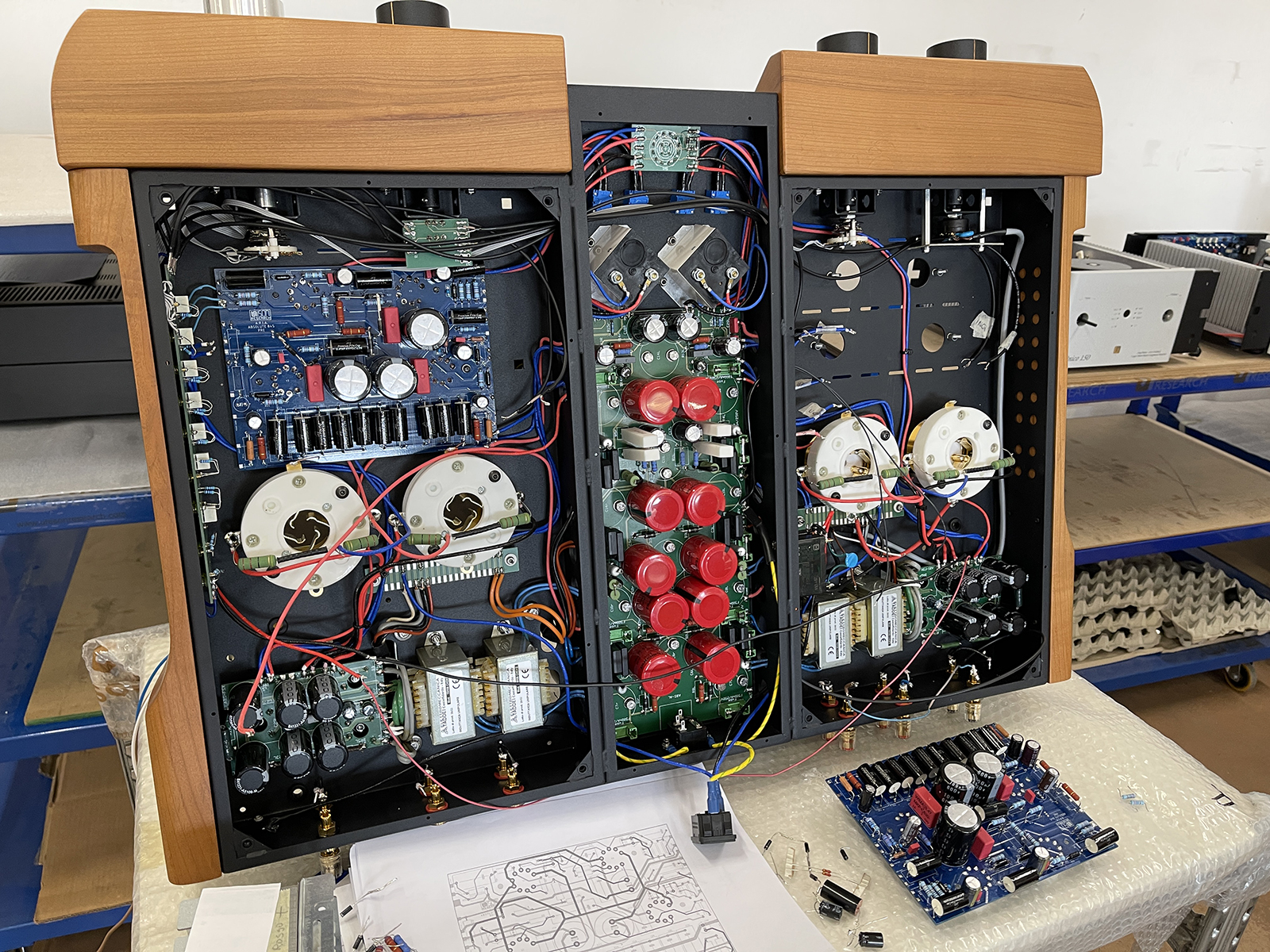 Tidy board and component layouts with cleanly routed wiring are a hallmark of Unison electronics. That and the robust (read massive) power supplies were everywhere to be seen, from their biggest dual mono-tube amplifier to their most affordable hybrid integrated. Unison is anything but stingy when it comes to the capabilities of the transformers used.
Tidy board and component layouts with cleanly routed wiring are a hallmark of Unison electronics. That and the robust (read massive) power supplies were everywhere to be seen, from their biggest dual mono-tube amplifier to their most affordable hybrid integrated. Unison is anything but stingy when it comes to the capabilities of the transformers used.
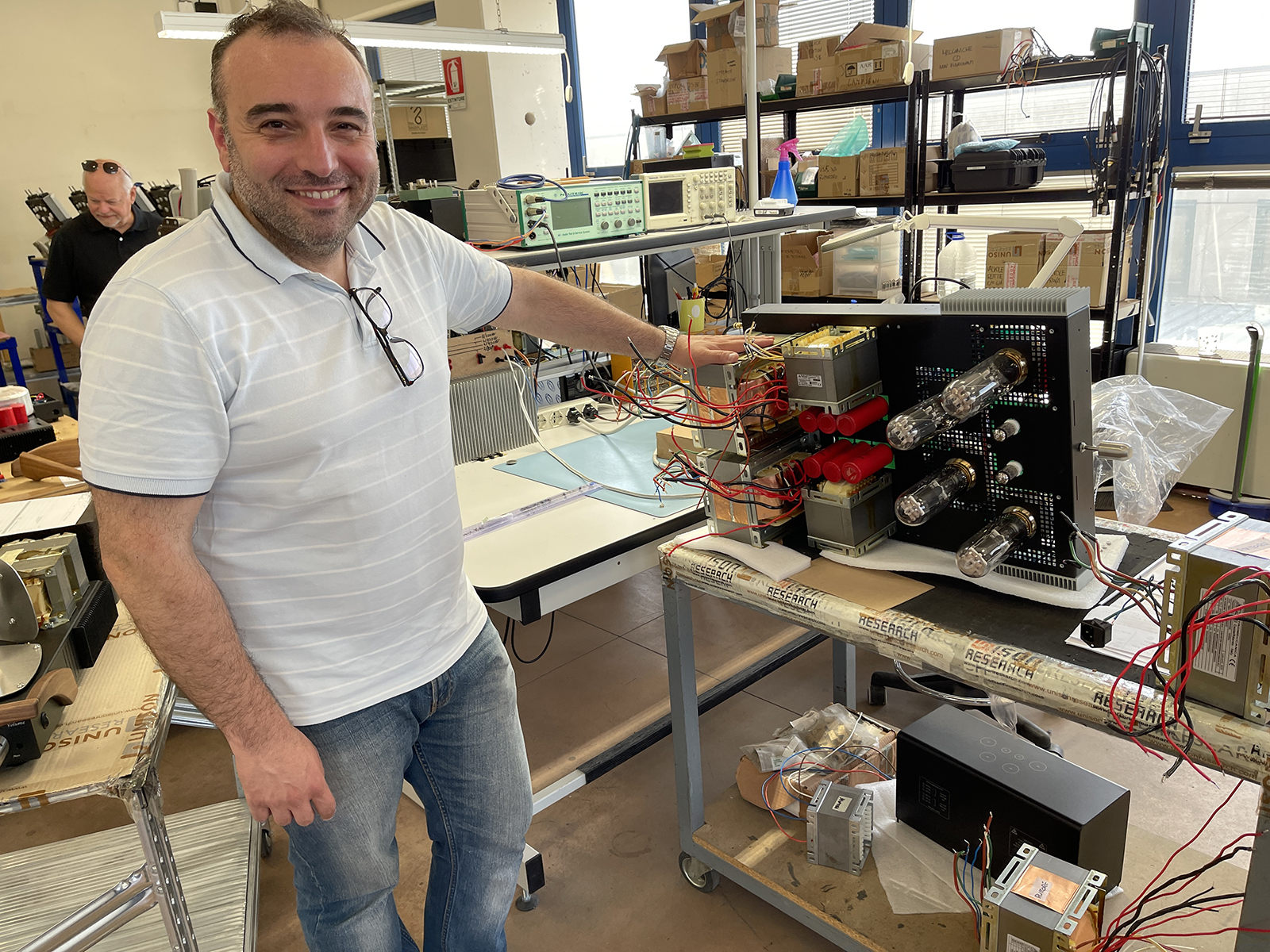
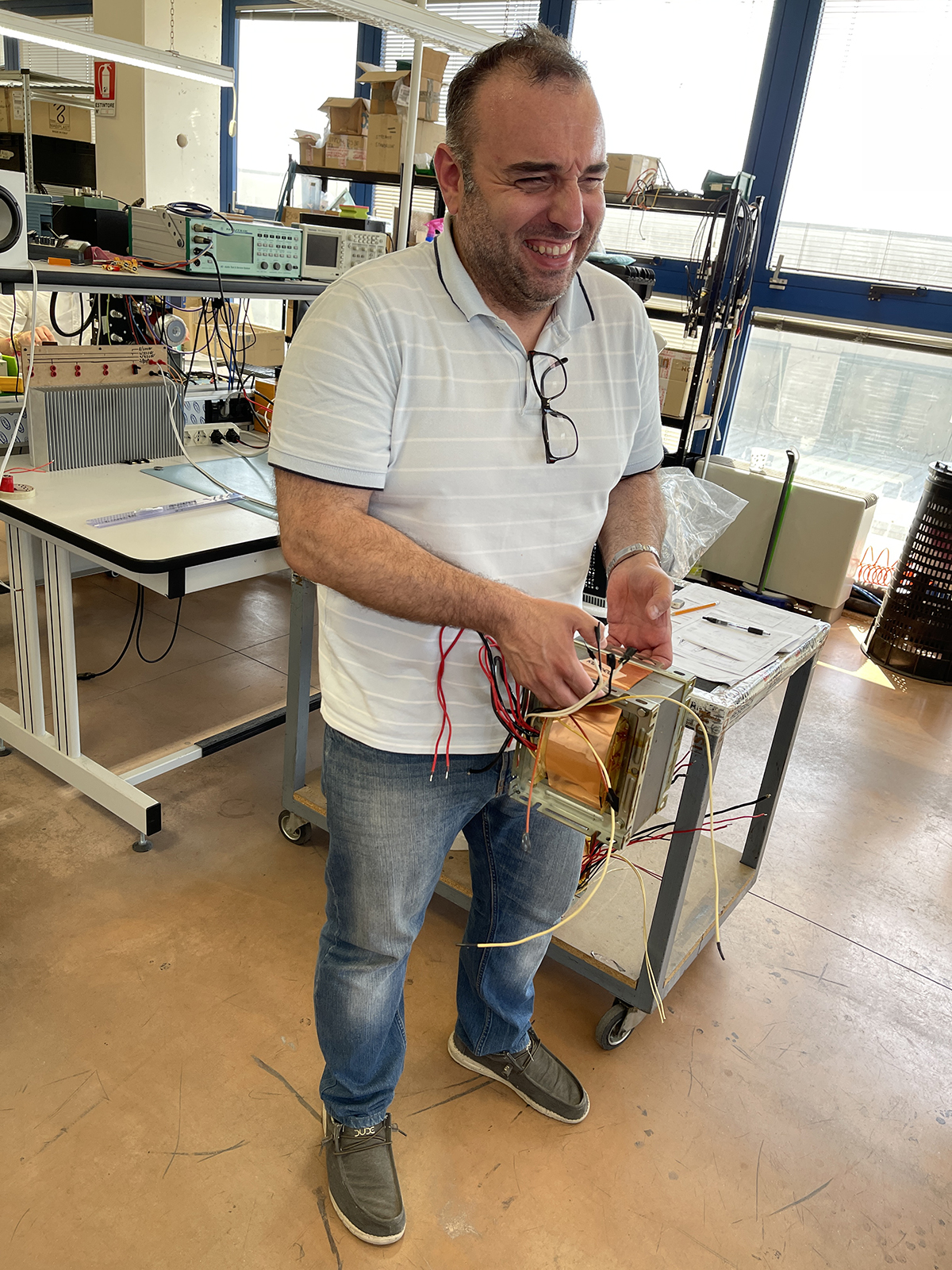 Bartolomeo decides to gamble on giving himself a hernia by deadlifting an iron core tranny as big as my head to prove the point. And that big, beautiful transformer is made in Italy, not very far from where we currently are.
Bartolomeo decides to gamble on giving himself a hernia by deadlifting an iron core tranny as big as my head to prove the point. And that big, beautiful transformer is made in Italy, not very far from where we currently are.
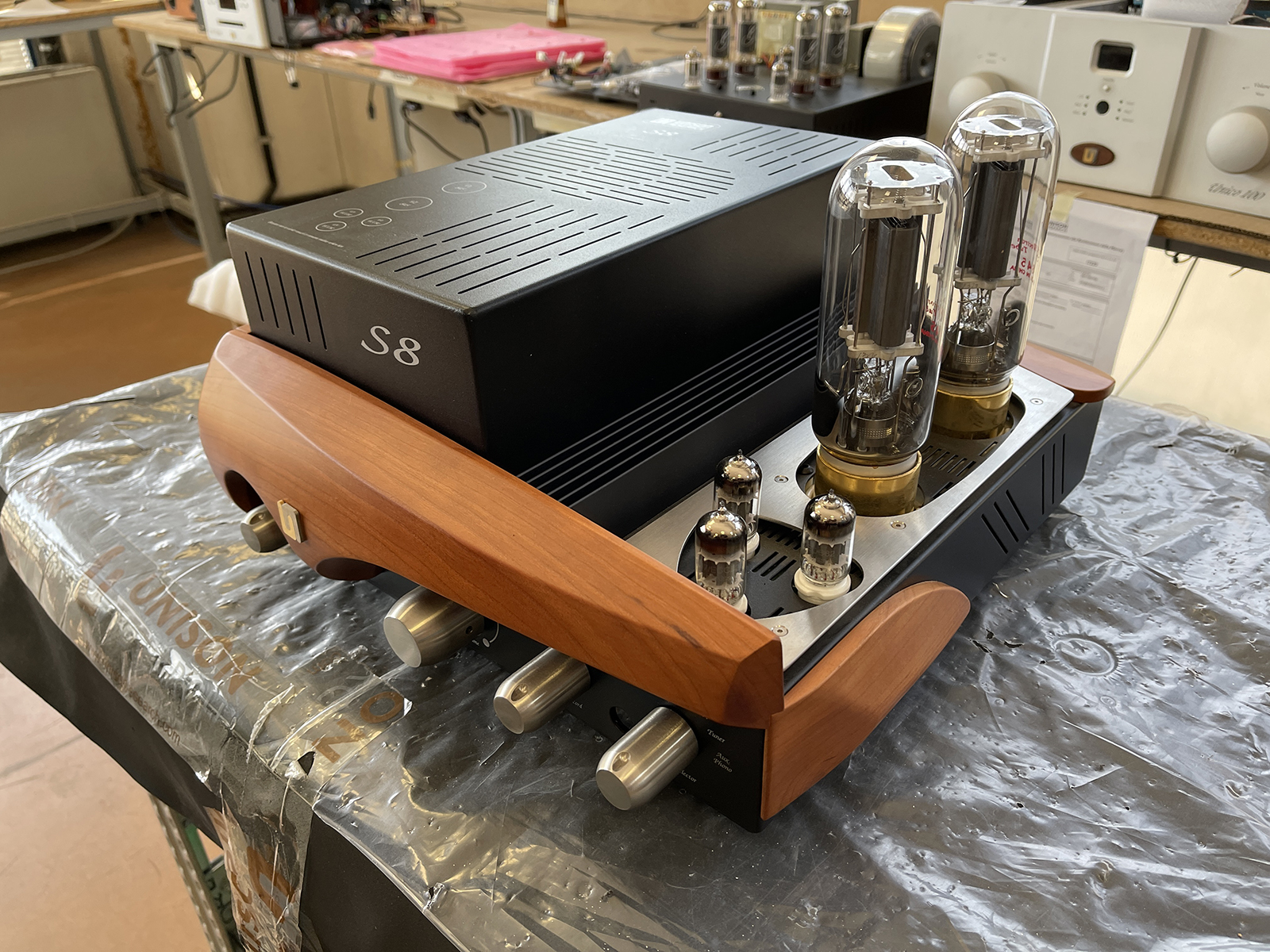
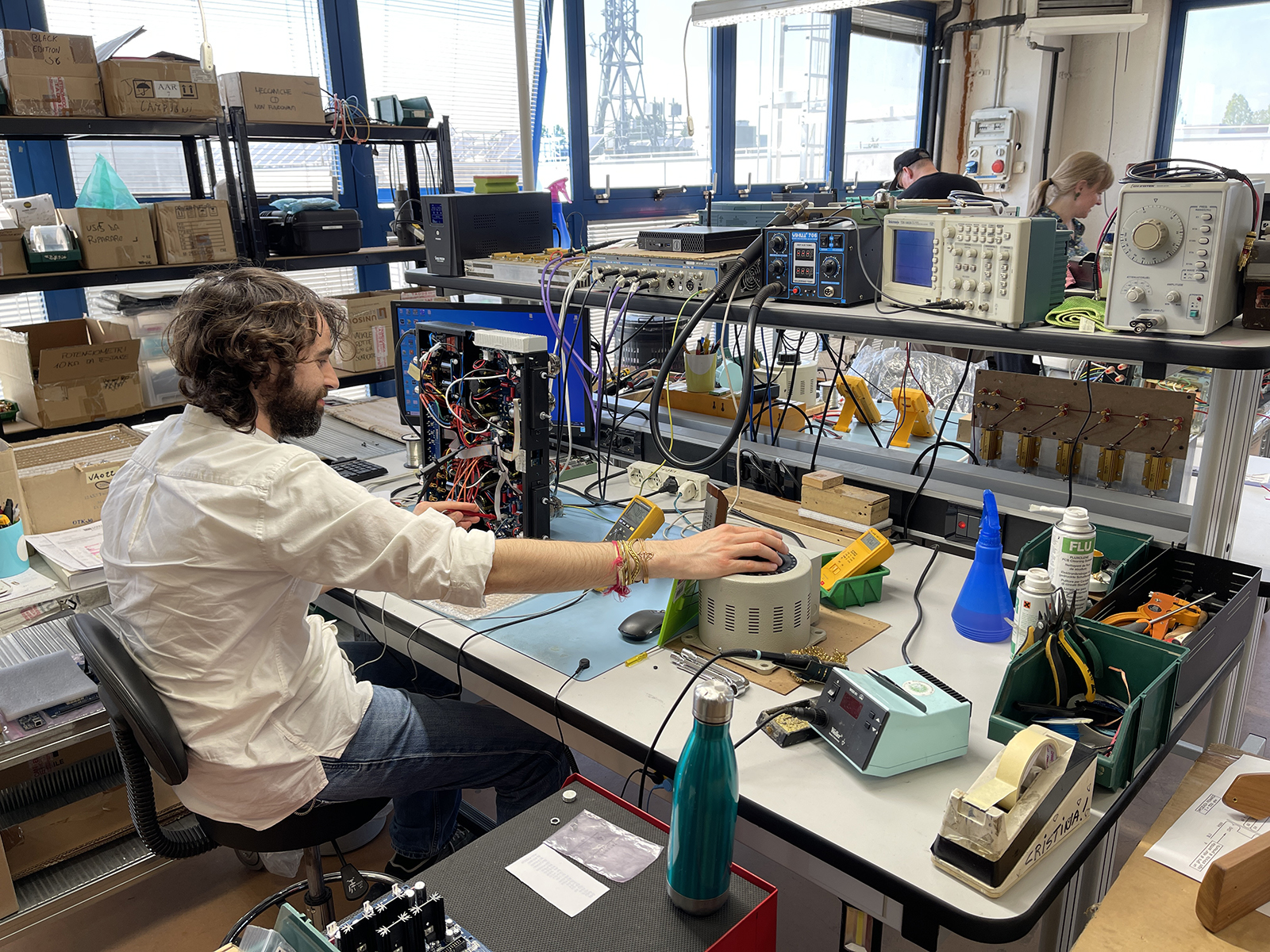 Finally, everything is tested and verified with an Audio Precision Analyzer to make sure it meets specifications before being packaged for shipment. Seeing this operation in person, it is beyond evident that the roughly two dozen employees of Unison and Opera care deeply about what they do here. They are producing some of the best that Italy has to offer, and they are understandably proud of that.
Finally, everything is tested and verified with an Audio Precision Analyzer to make sure it meets specifications before being packaged for shipment. Seeing this operation in person, it is beyond evident that the roughly two dozen employees of Unison and Opera care deeply about what they do here. They are producing some of the best that Italy has to offer, and they are understandably proud of that.
We rounded out our official day with some casual listening sessions. Unison/Opera has one nicely sized and laid out listening room on the third floor (plans are afoot to add 3 more) where we began our auditioning with a pair of white Opera Grand Callas speakers being driven off a Unison Unico 90 integrated amp and streaming tracks off of Qobuz as the source.
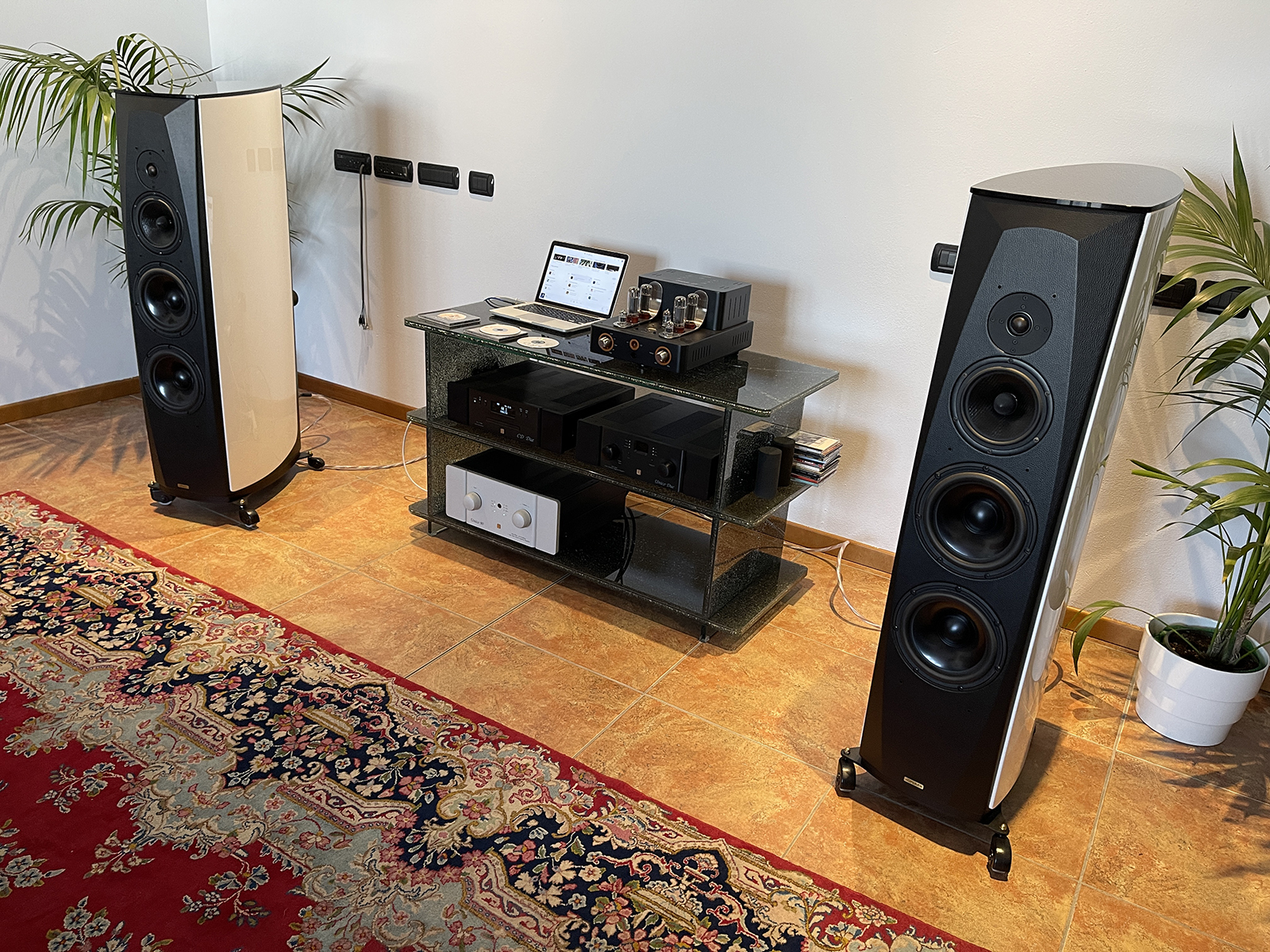 Immediately you get this lush, appealing (and very Italian) sound from the Opera speakers. Smooth, yet detailed highs, a fulsome midrange, and a very solid bass extension. These speakers are made for you to relax and savor the music you’re listening to. Next, Bart and Riccardo wheeled in a pair of the Unison Max II speakers, like those I saw downstairs, to displace the Grand Callas and these were now being driven by the beautiful Unison Simply 845 Integrated Amplifier.
Immediately you get this lush, appealing (and very Italian) sound from the Opera speakers. Smooth, yet detailed highs, a fulsome midrange, and a very solid bass extension. These speakers are made for you to relax and savor the music you’re listening to. Next, Bart and Riccardo wheeled in a pair of the Unison Max II speakers, like those I saw downstairs, to displace the Grand Callas and these were now being driven by the beautiful Unison Simply 845 Integrated Amplifier.
The Max II presented a wholly different experience with that massive waveguide, more dynamic with really clean highs and a slamming bottom end. The midrange was a little recessed I thought, surprisingly not as forward as the Grand Callas. These are definitely speakers that I’d like to mess around with in my own listening space to get a better grasp of what they can do.
Our first day at Unison and Opera being now in the books, we regrouped at the hotel and then met at a quaint local eatery for a most delicious seafood dinner.

 “Italian Standard Time” was upon us again as the hours slipped by between fish courses; Bart’s supremely informative wine recommendations; more fish; discussions of life and audio; tiramisu; how Bart and Riccardo’s dad started the whole business; and this amazing lemony/prosecco/vodka Sgroppino palate cleanser cocktail that tasted so good that I wanted to bathe in it. Before we knew it the hour was well late, but it was decided that a short night’s walk through Treviso was called for. Both to experience the town’s ancient beauty by night and to make us collectively feel marginally less “roly-poly” before bed.
“Italian Standard Time” was upon us again as the hours slipped by between fish courses; Bart’s supremely informative wine recommendations; more fish; discussions of life and audio; tiramisu; how Bart and Riccardo’s dad started the whole business; and this amazing lemony/prosecco/vodka Sgroppino palate cleanser cocktail that tasted so good that I wanted to bathe in it. Before we knew it the hour was well late, but it was decided that a short night’s walk through Treviso was called for. Both to experience the town’s ancient beauty by night and to make us collectively feel marginally less “roly-poly” before bed.
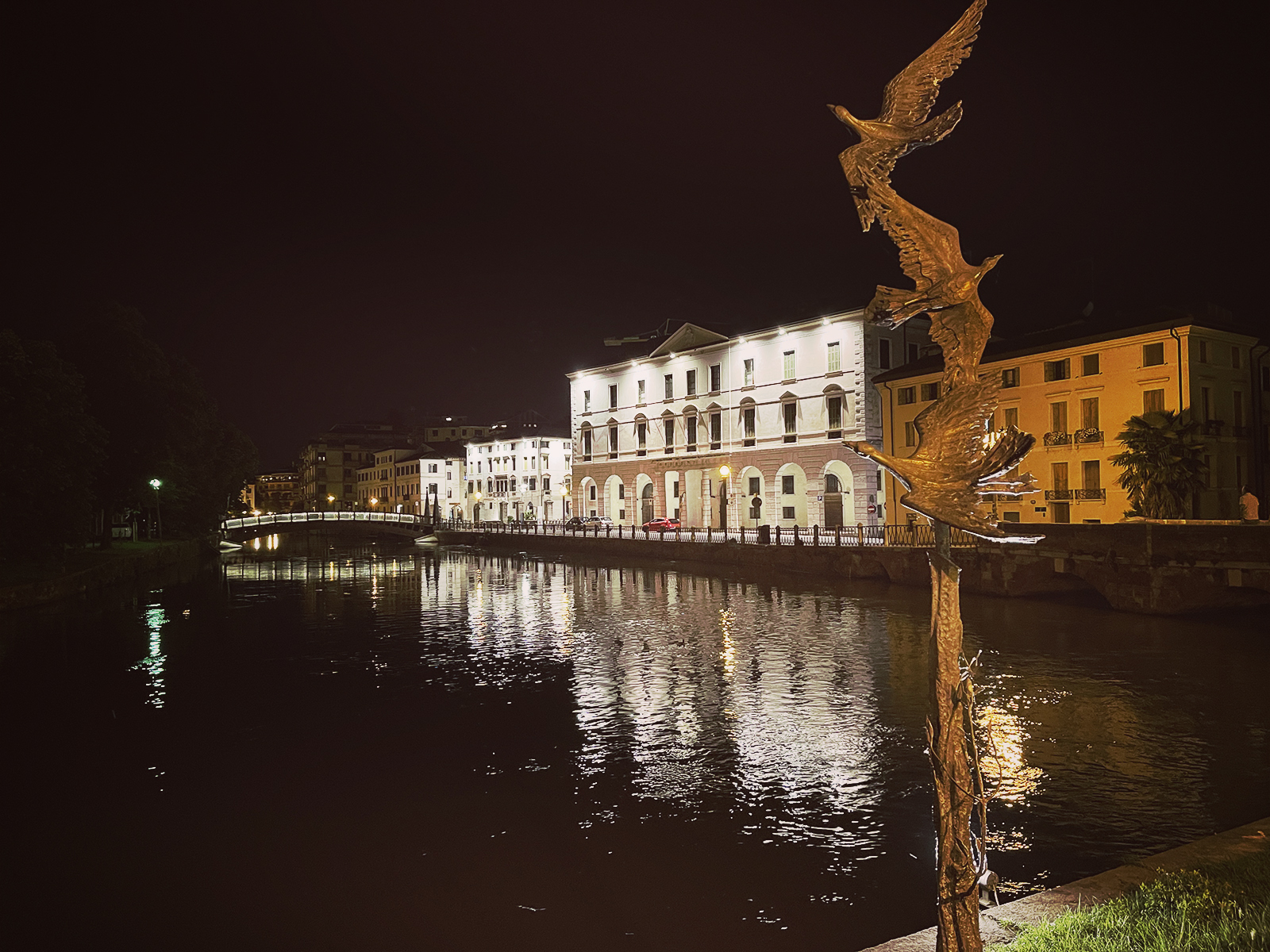
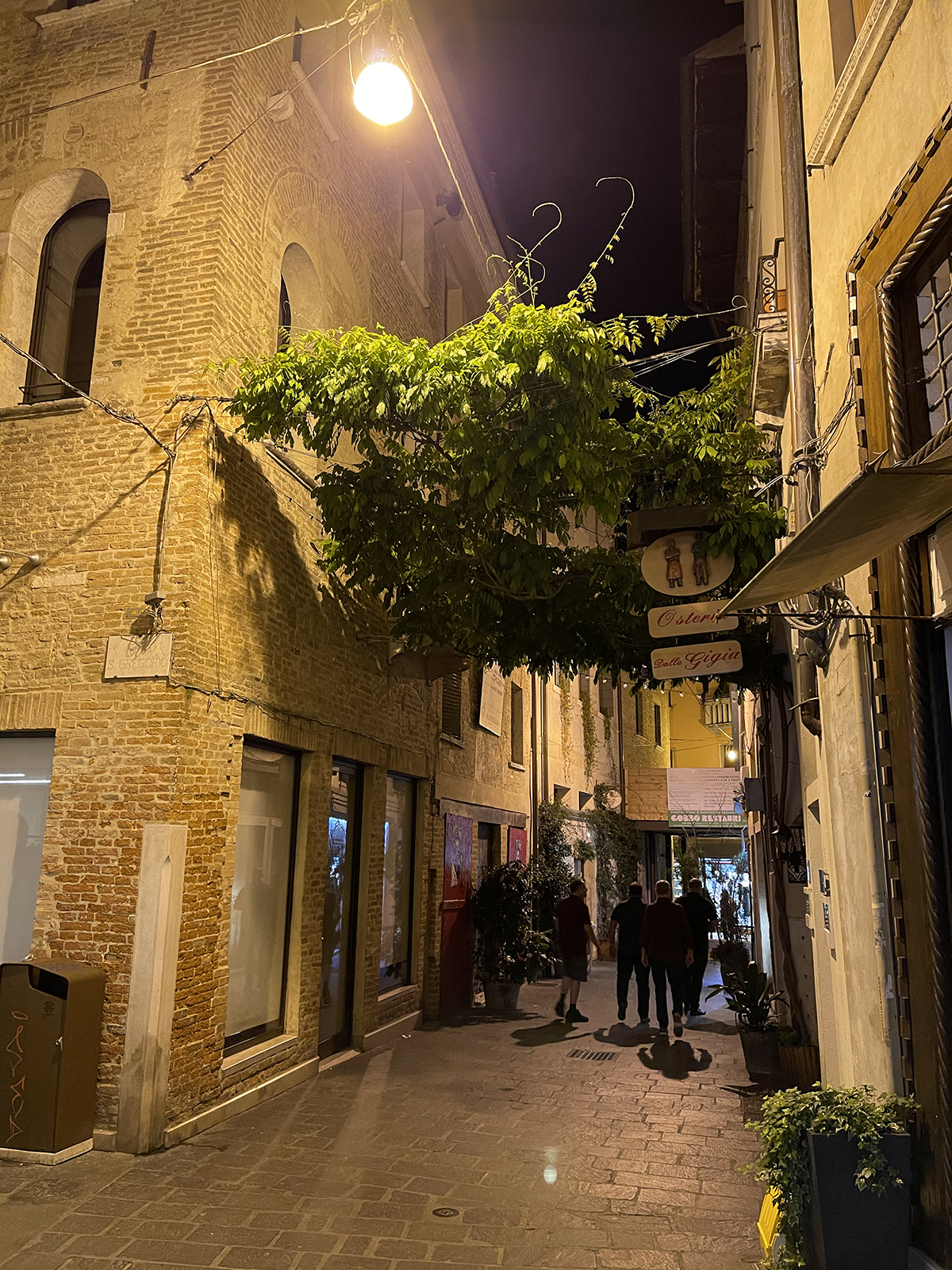
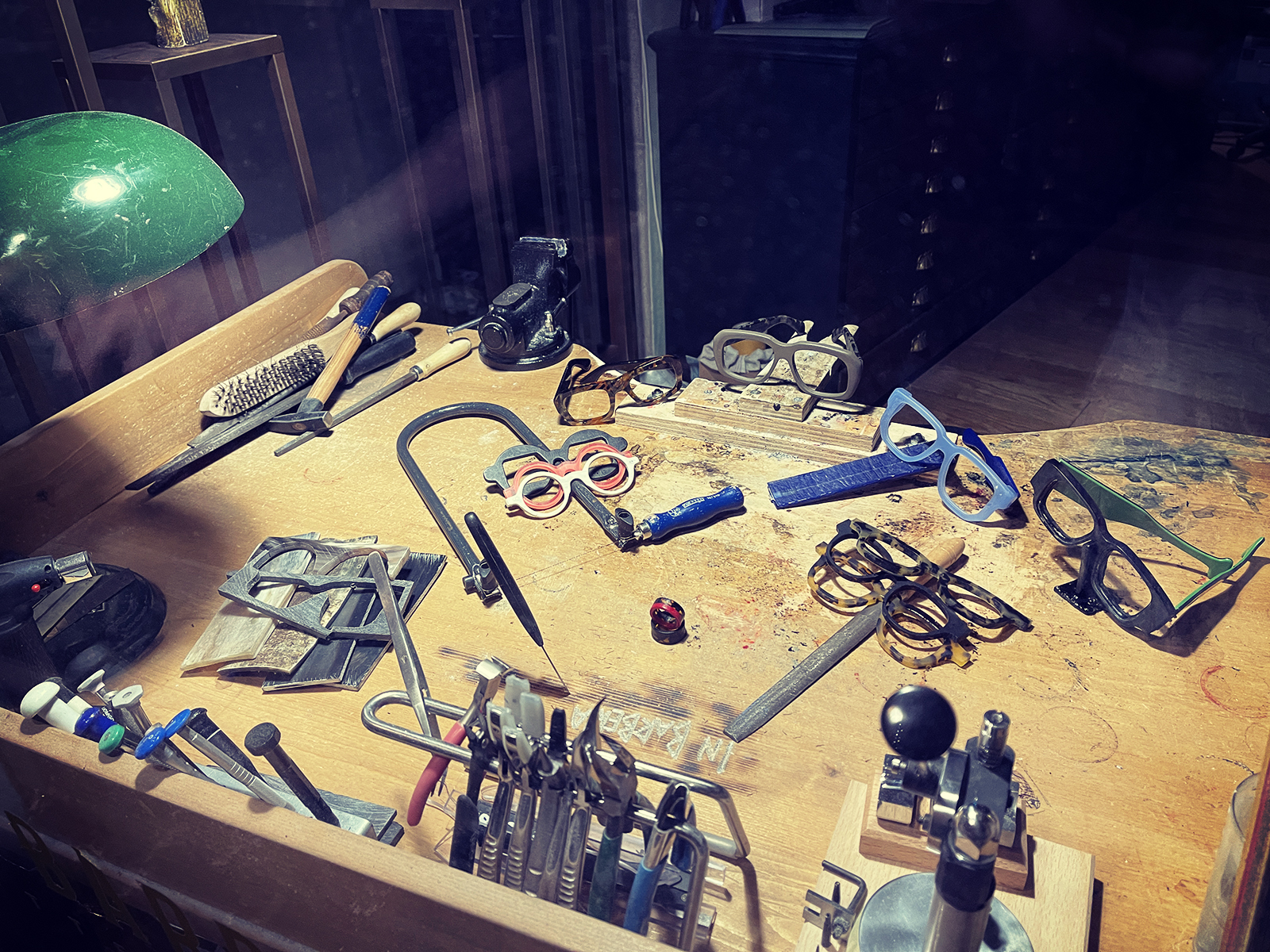
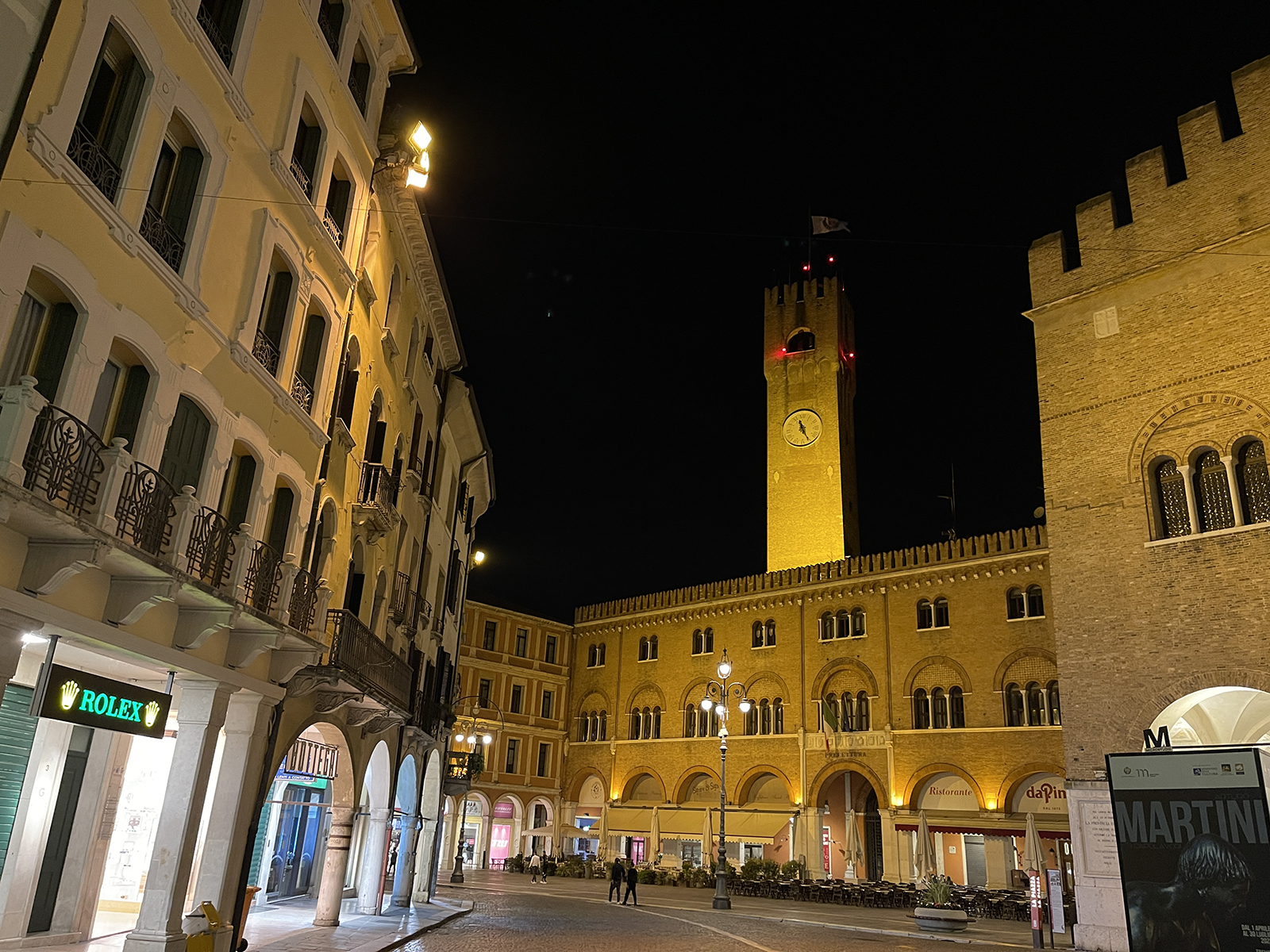 History, craftsmanship, and passion are very evident when strolling Treviso by the light of street lamps. It’s a very befitting place to reflect upon and wrap up our first day.
History, craftsmanship, and passion are very evident when strolling Treviso by the light of street lamps. It’s a very befitting place to reflect upon and wrap up our first day.
As our intrepid crew got ourselves together to begin day two, it should be noted that I made a new best friend while visiting Unison/Opera.
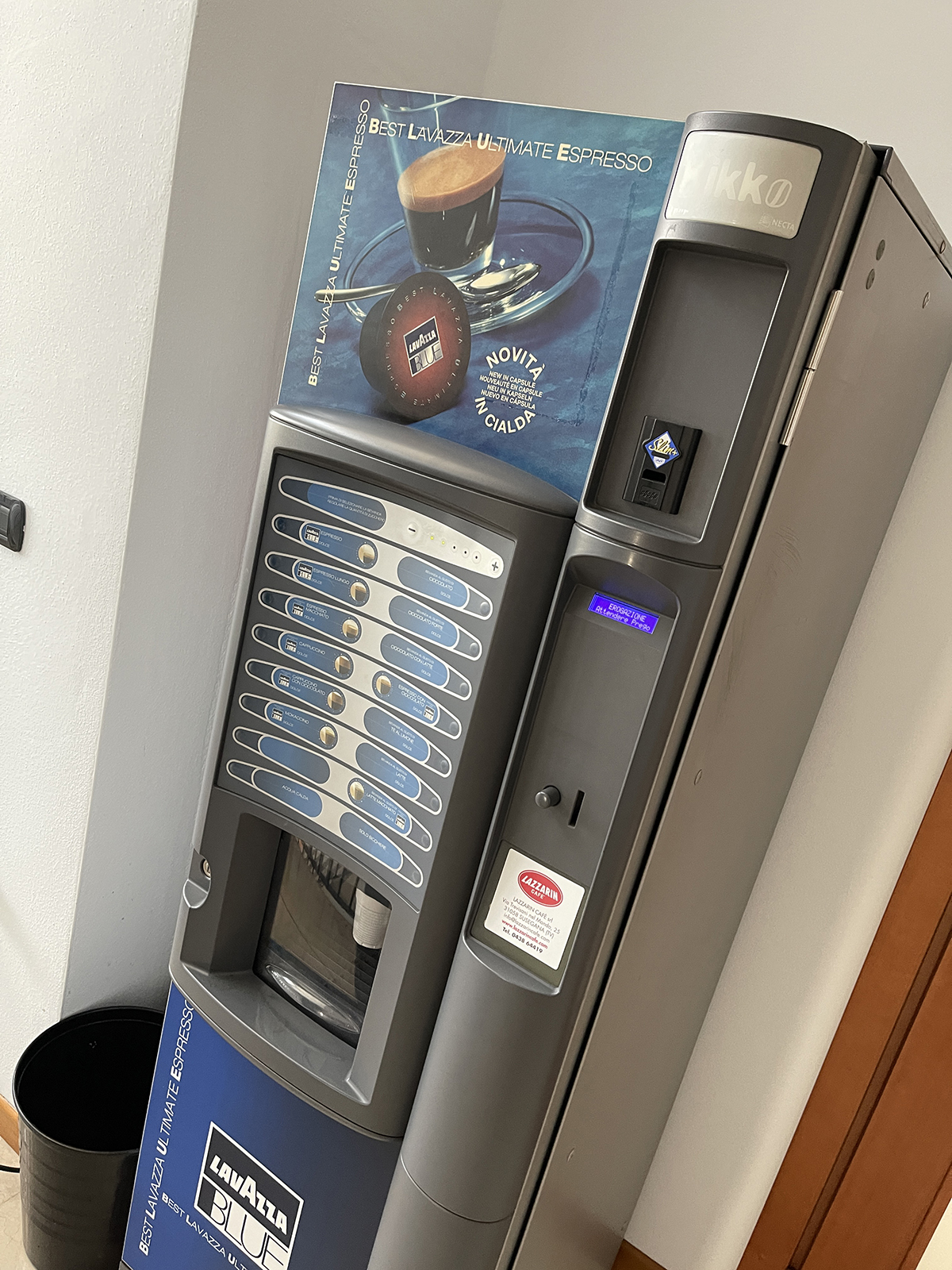 This friend wasn’t a person per se, but this LavAzza espresso beverage dispenser that was strategically placed in the lobby area for easy personal caffeinating at the push of a button. The sad thing is that this beautiful blue monolith made better cappuccinos than several living baristas I have come across! Even now I miss it so!
This friend wasn’t a person per se, but this LavAzza espresso beverage dispenser that was strategically placed in the lobby area for easy personal caffeinating at the push of a button. The sad thing is that this beautiful blue monolith made better cappuccinos than several living baristas I have come across! Even now I miss it so!
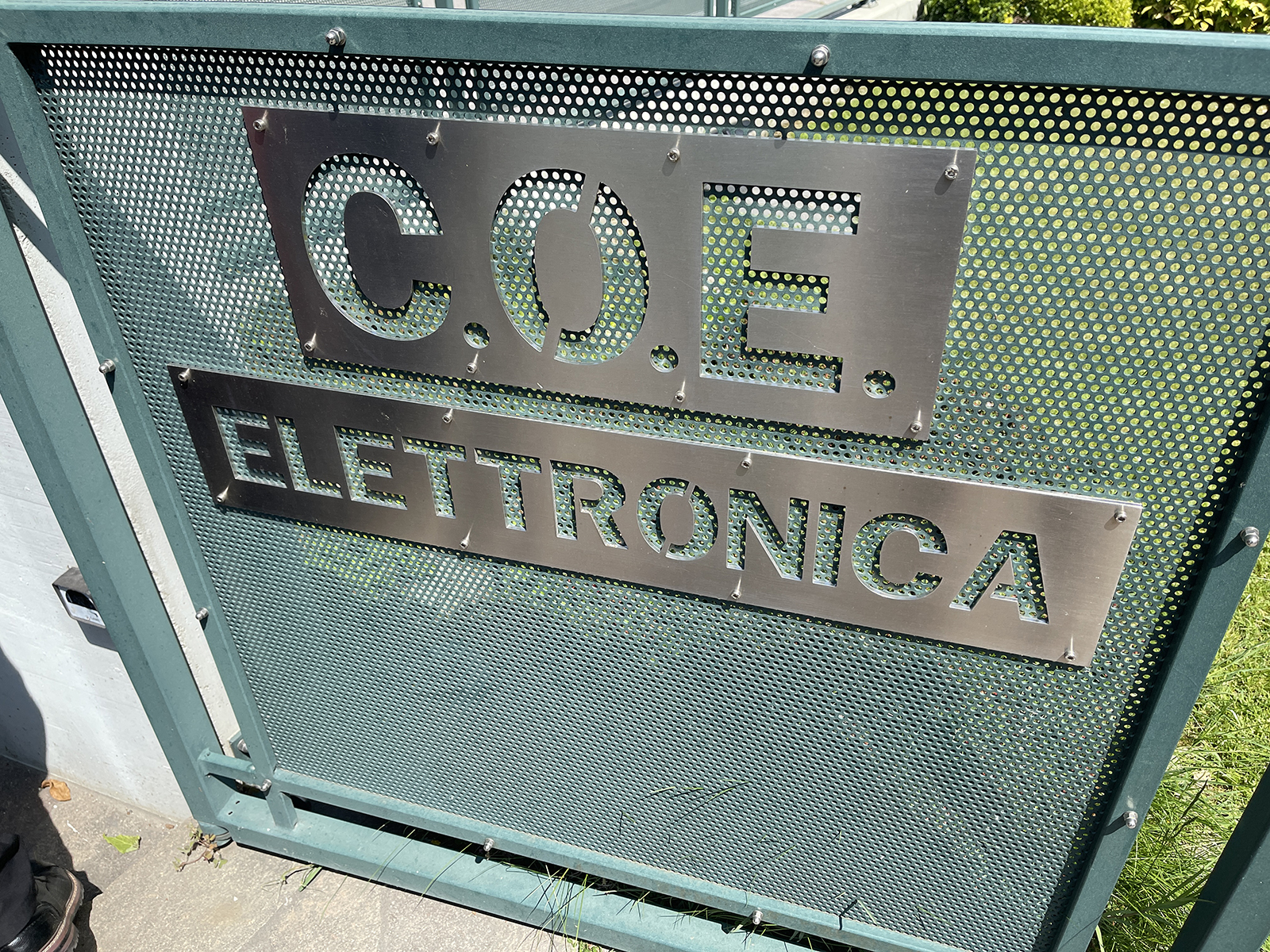 Caffeinated and buzzing, our first stop today was at C.O.E. Elettronica, a local electronics fab that specializes in creating circuit boards and populating them with surface-mounted components. Unison contracts with them to produce and populate their boards. It’s another Italian family-run operation that started in 1982 and is currently run by the father, Graziano, and his two sons.
Caffeinated and buzzing, our first stop today was at C.O.E. Elettronica, a local electronics fab that specializes in creating circuit boards and populating them with surface-mounted components. Unison contracts with them to produce and populate their boards. It’s another Italian family-run operation that started in 1982 and is currently run by the father, Graziano, and his two sons.
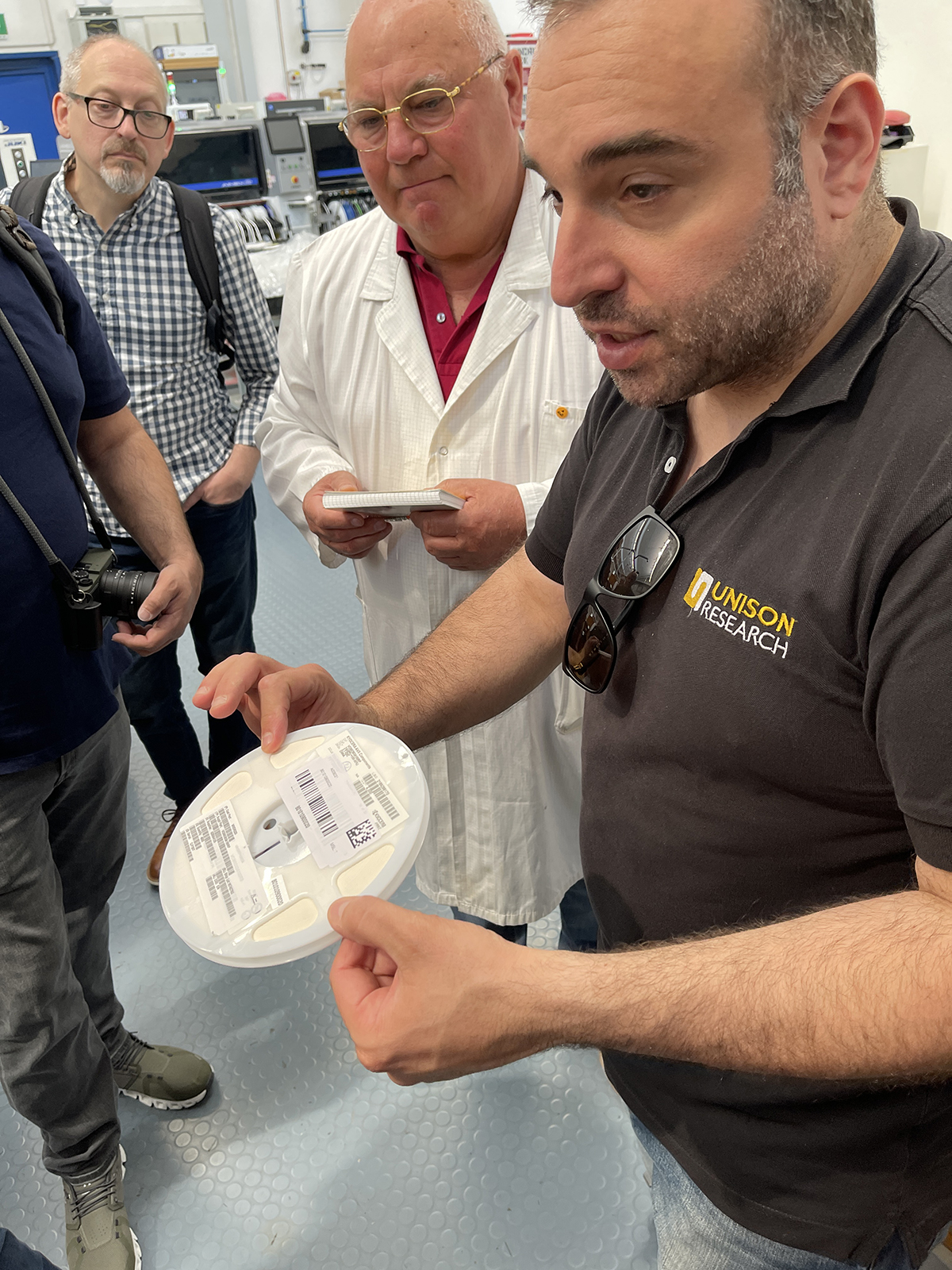
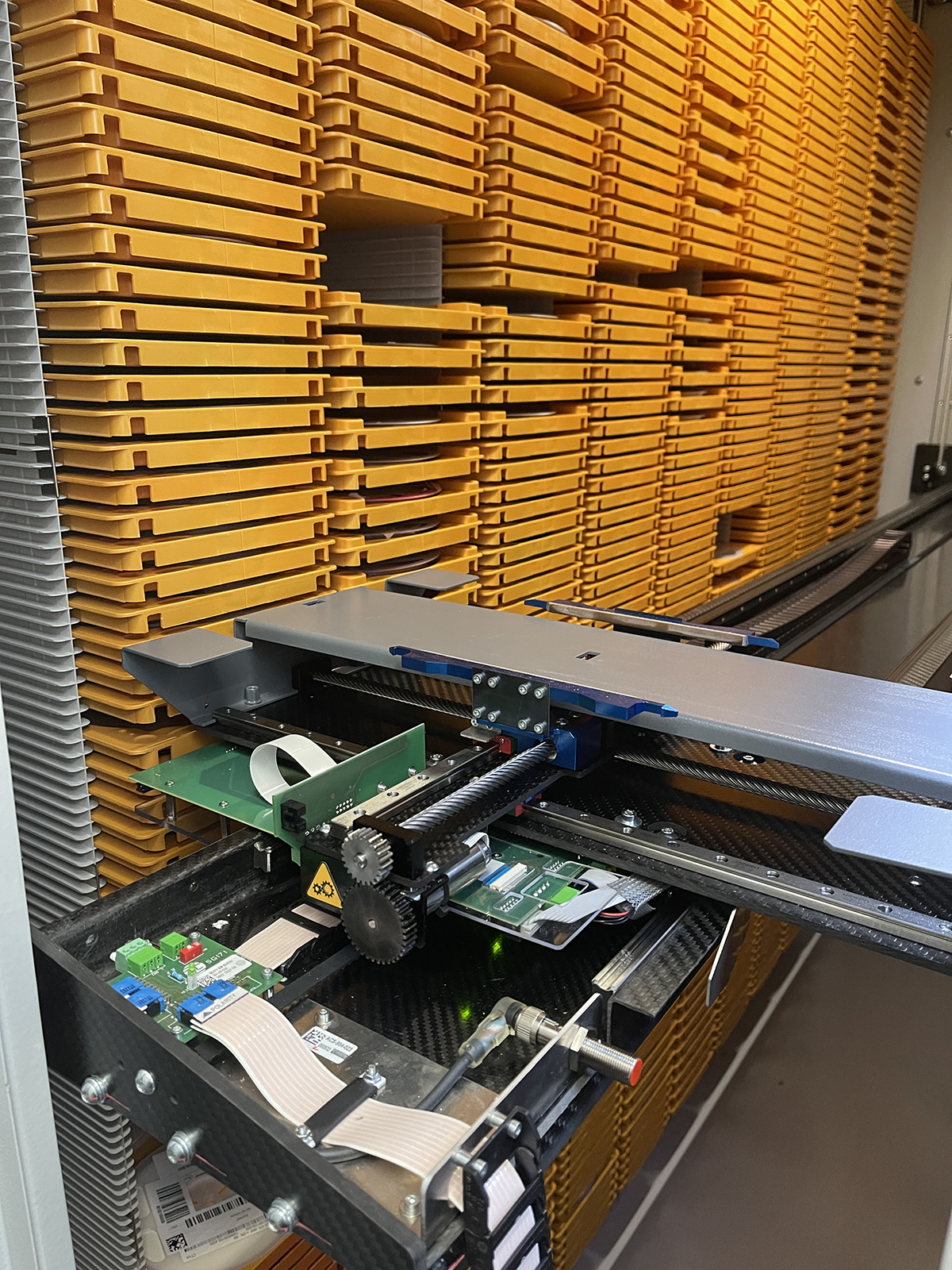 It is a seriously automated operation with several pick-and-place machines, machines that mount tiny chips and components stored on reels of tape, and machines that solder using what seem like rivers of molten lava.
It is a seriously automated operation with several pick-and-place machines, machines that mount tiny chips and components stored on reels of tape, and machines that solder using what seem like rivers of molten lava.
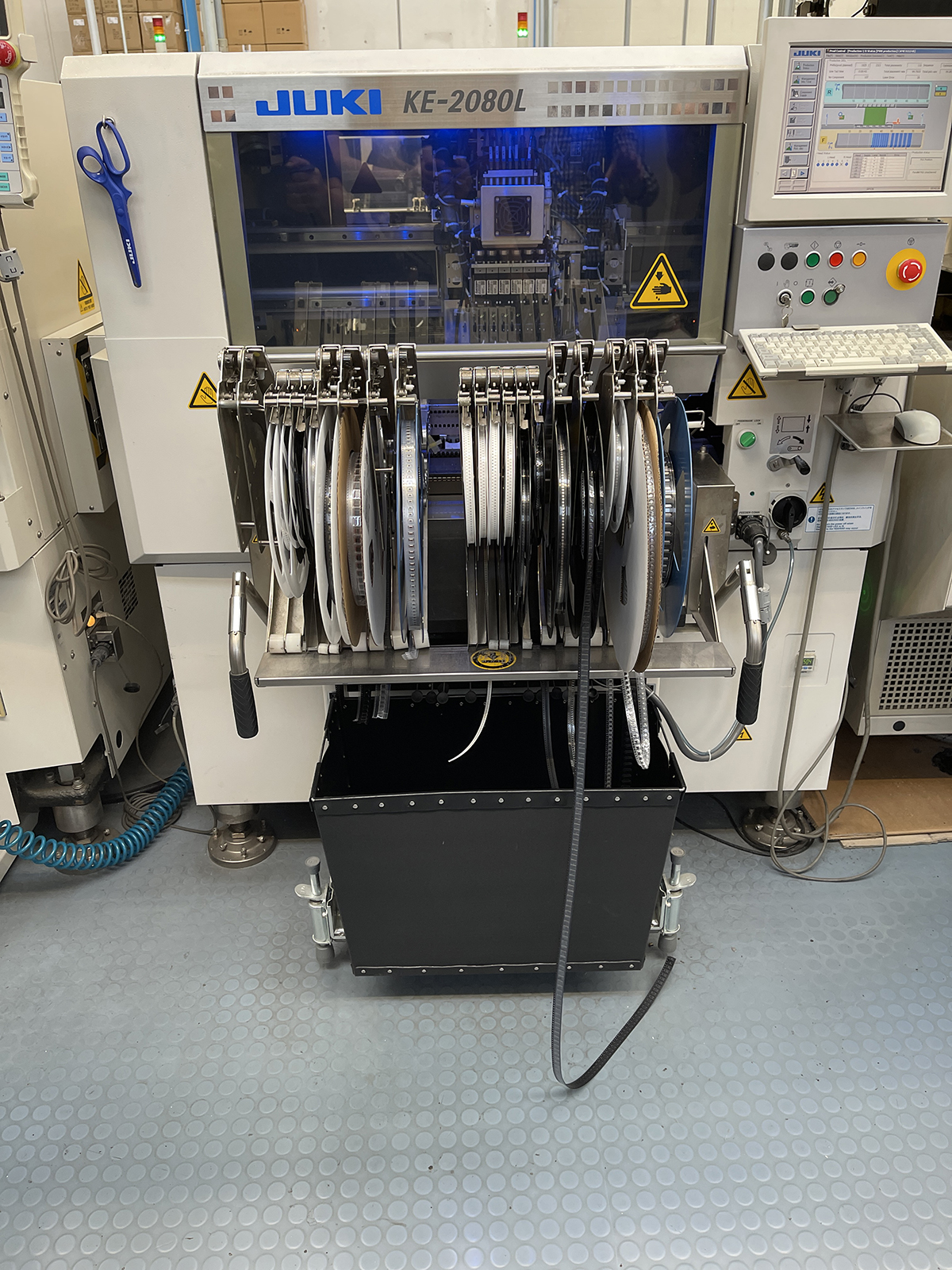
 And yet the personal touch remains with larger resistors, capacitors, valve connectors, and the like all still populated by hand.
And yet the personal touch remains with larger resistors, capacitors, valve connectors, and the like all still populated by hand.
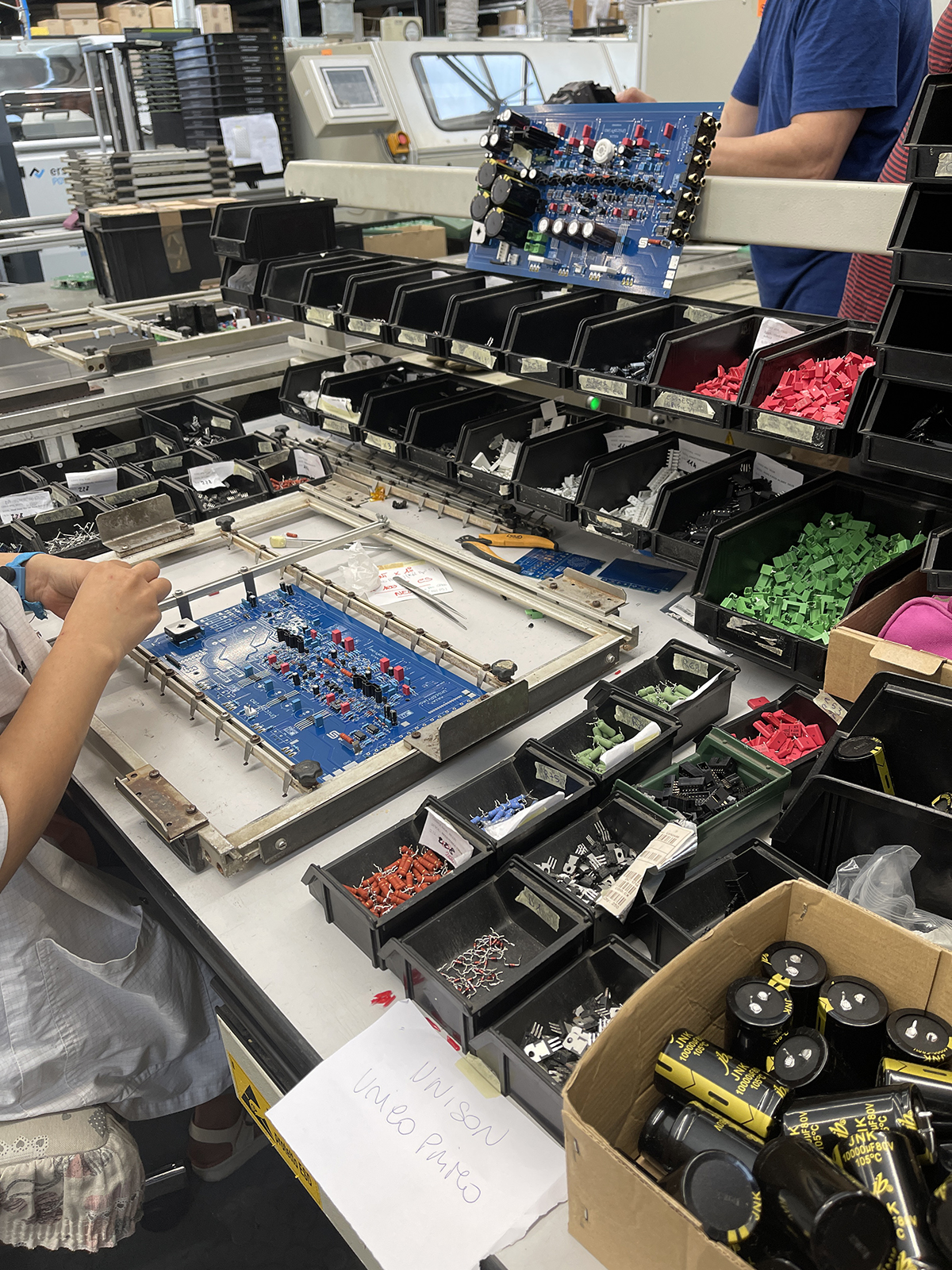 Graziano proudly walks us through every inch of this facility noting the precision of how everything, every little component, is computer coded and cataloged so that when a series of boards need to be produced, everything comes together accurately and in order.
Graziano proudly walks us through every inch of this facility noting the precision of how everything, every little component, is computer coded and cataloged so that when a series of boards need to be produced, everything comes together accurately and in order.
While not exactly a true “clean room” it feels just about like one with every little detail, everywhere seemingly in its place and barely a speck of dirt to be seen. While not divulging its client list, C.O.E. Elletronica’s precision skills are also put to work for the automotive industry, particularly within the subsystems of electric cars.
This is light years beyond a few guys with soldering irons putting kit amps together. But the human hand is still unquestionably there. A very enlightening visit.
We shuttled back to Unison/Opera HQ where last up was a surprise speaker comparison. The Nasta brothers have been working on ideas for a more affordable line of loudspeakers and they had a current prototype/test mule bookshelf speaker that they wanted us to listen to and give them some initial feedback on. We were of course asked not to take any photos of the prototype, but I can tell you that it was a roughly made MDF mule with an external crossover. The components were held together with alligator clips for quick value changes, but it looked for all the world like this little speaker had crossover “dreadlocks” hanging off its head! Bart and Riccardo wanted us to compare the sound of the new prototype speaker to the sound of an Opera Callas bookshelf speaker. Not so much because they were targeting the Callas’ sound signature, but more to illustrate the difference in voicing that they were going after with this new product. Playing the little prototype speaker first, the sound was lively and pleasing to listen to. It had great bass extension for its size and the midrange did very well with vocals and instrumental clarity. The upper mids to treble may have been a touch bright for my taste but it wasn’t irritating at all. Swapping in the Callas bookshelves gave us a decidedly darker and smoother presentation. The highs on the Callas were not as bright as the mule’s and while both speakers imaged well, I felt that the Callas painted a slightly more cohesive picture. It was fun to hear and compare everyone’s impressions.
As we wound down our time here at Unison/Opera it was only fitting that we ended our visit as we began it, by eating. Donatella, Bartolomeo, and Riccardo brought us together for a farewell lunch at a very special restaurant. “Osteria alla Sicilia, Casa Vian” is owned by close personal friends of the family.
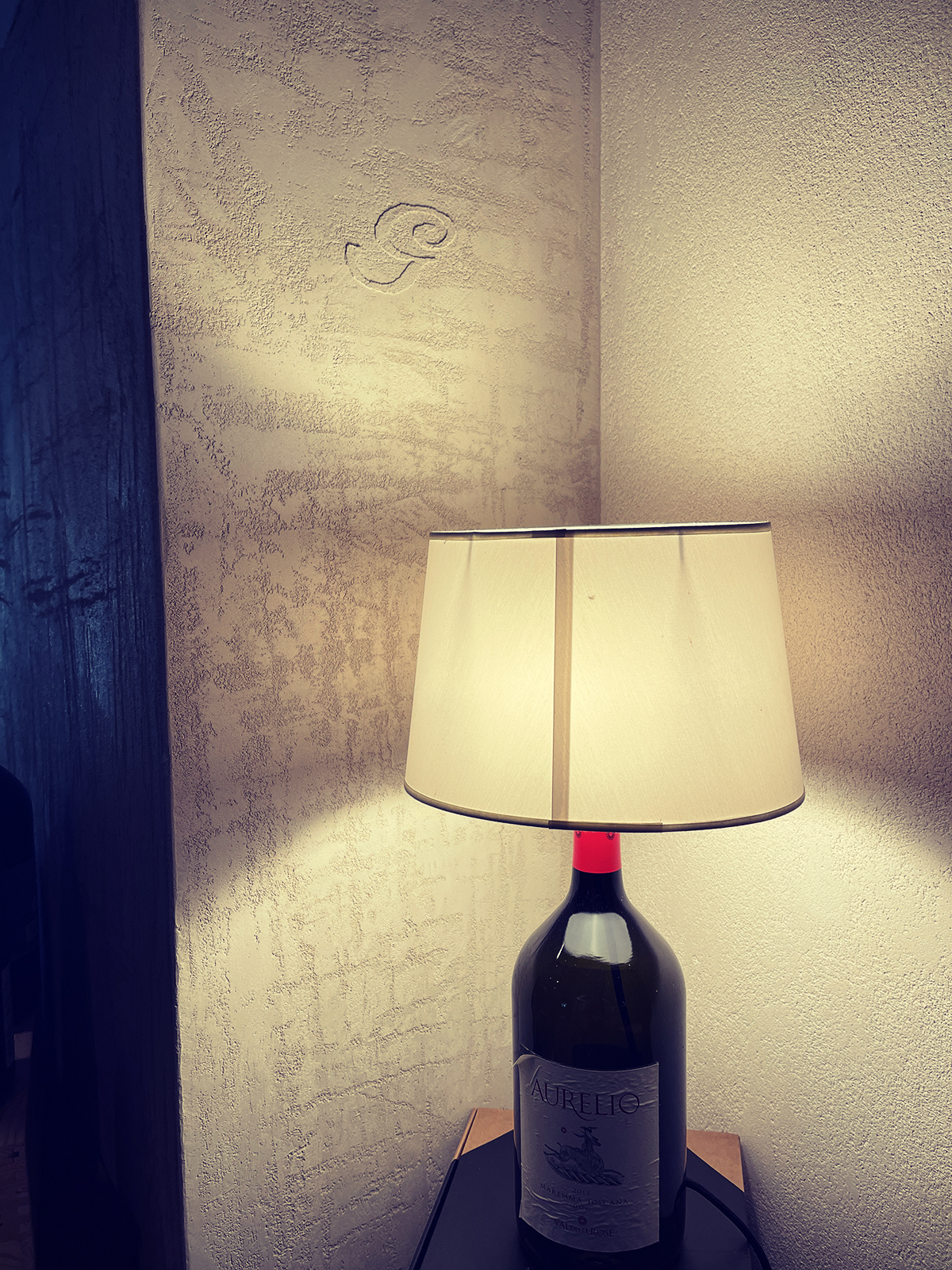
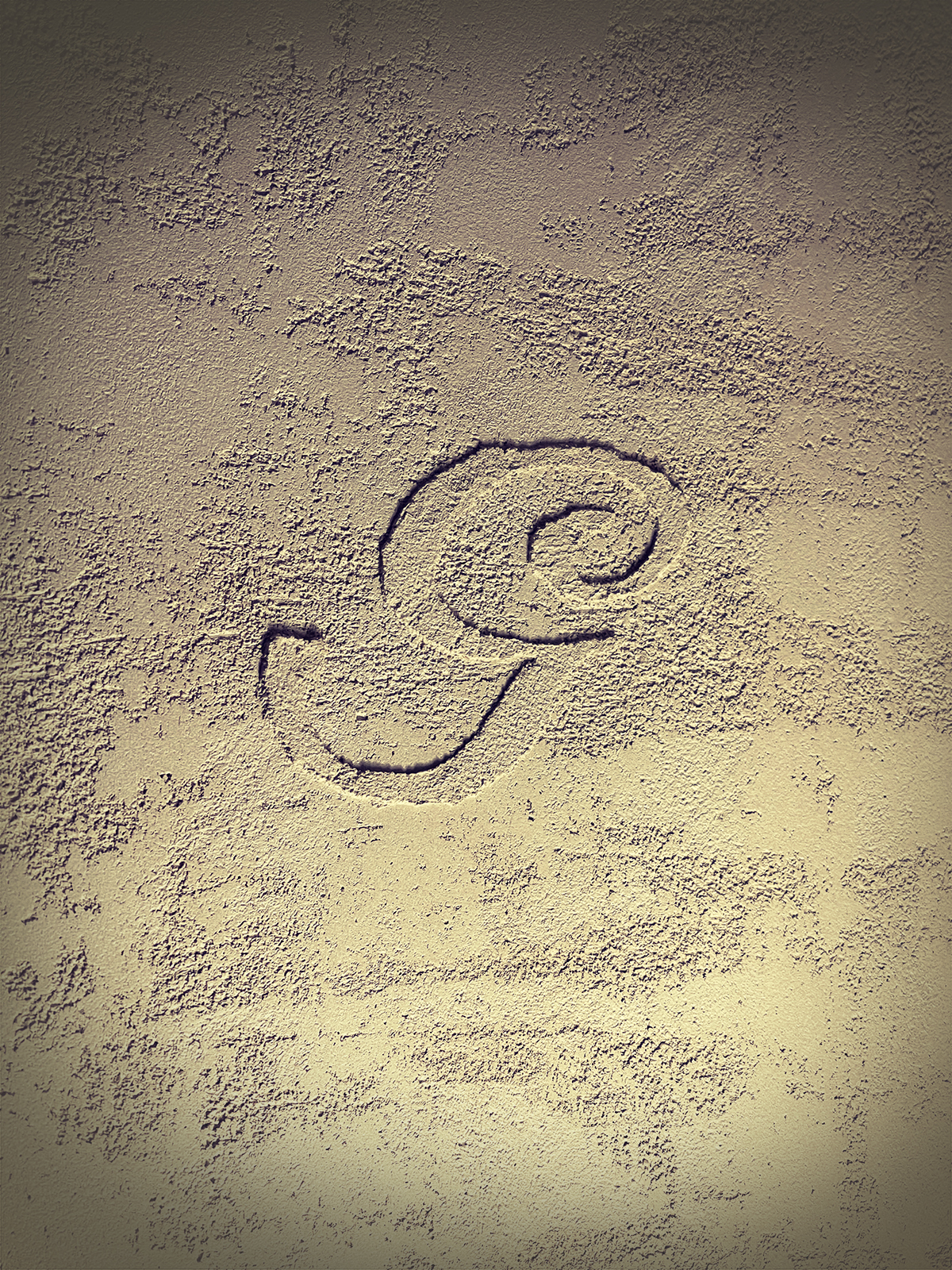 So close a friendship, that the first initial of Opera Loudspeaker’s founder (and the family’s patriarch) Giovanni Nasta is prominently and permanently sculpted into the wall at the entrance.
So close a friendship, that the first initial of Opera Loudspeaker’s founder (and the family’s patriarch) Giovanni Nasta is prominently and permanently sculpted into the wall at the entrance.
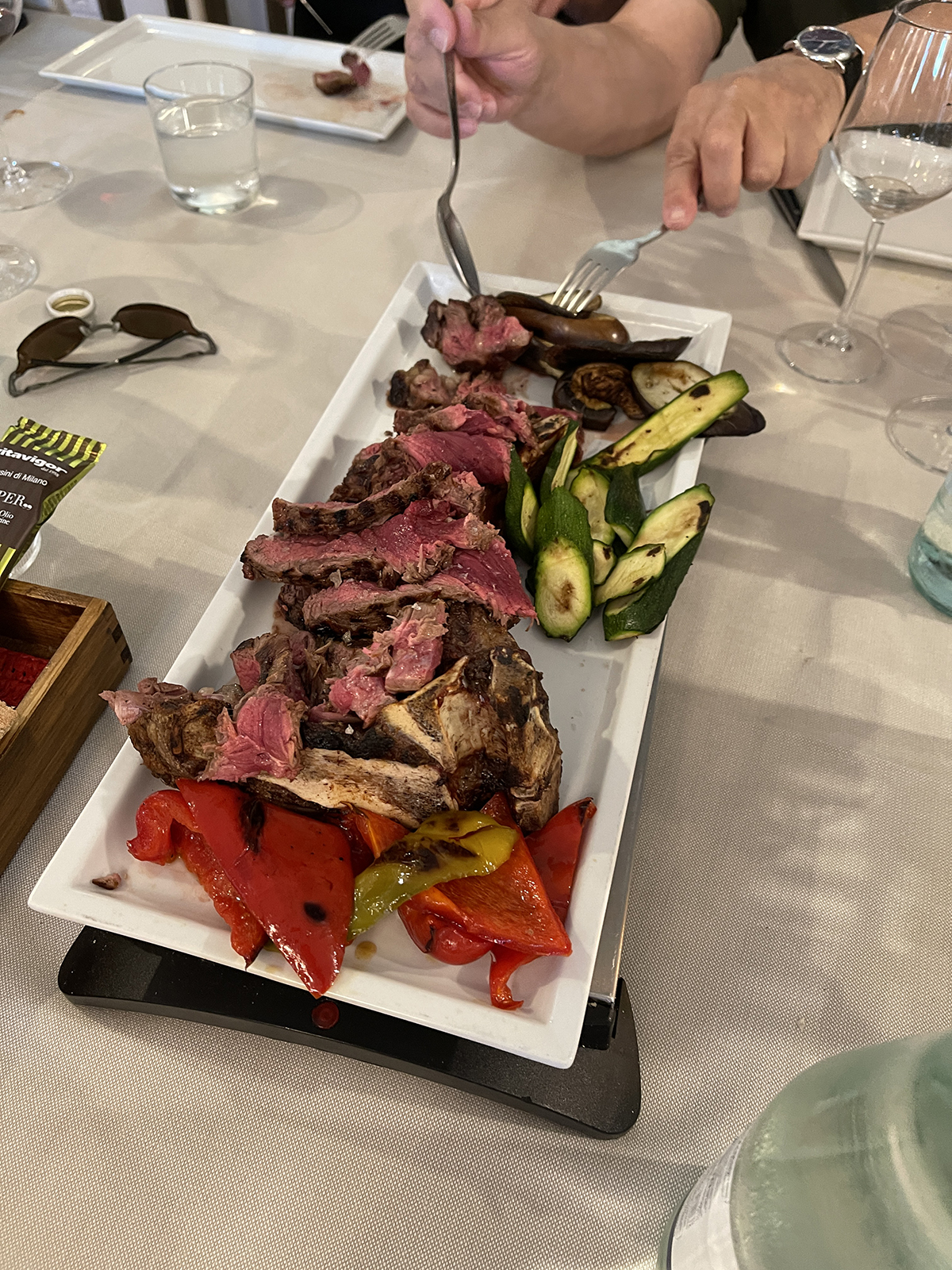
 It was here that we literally broke bread over one of the finest meals I have ever experienced. It was astonishingly good, but even more so was the company.
It was here that we literally broke bread over one of the finest meals I have ever experienced. It was astonishingly good, but even more so was the company.
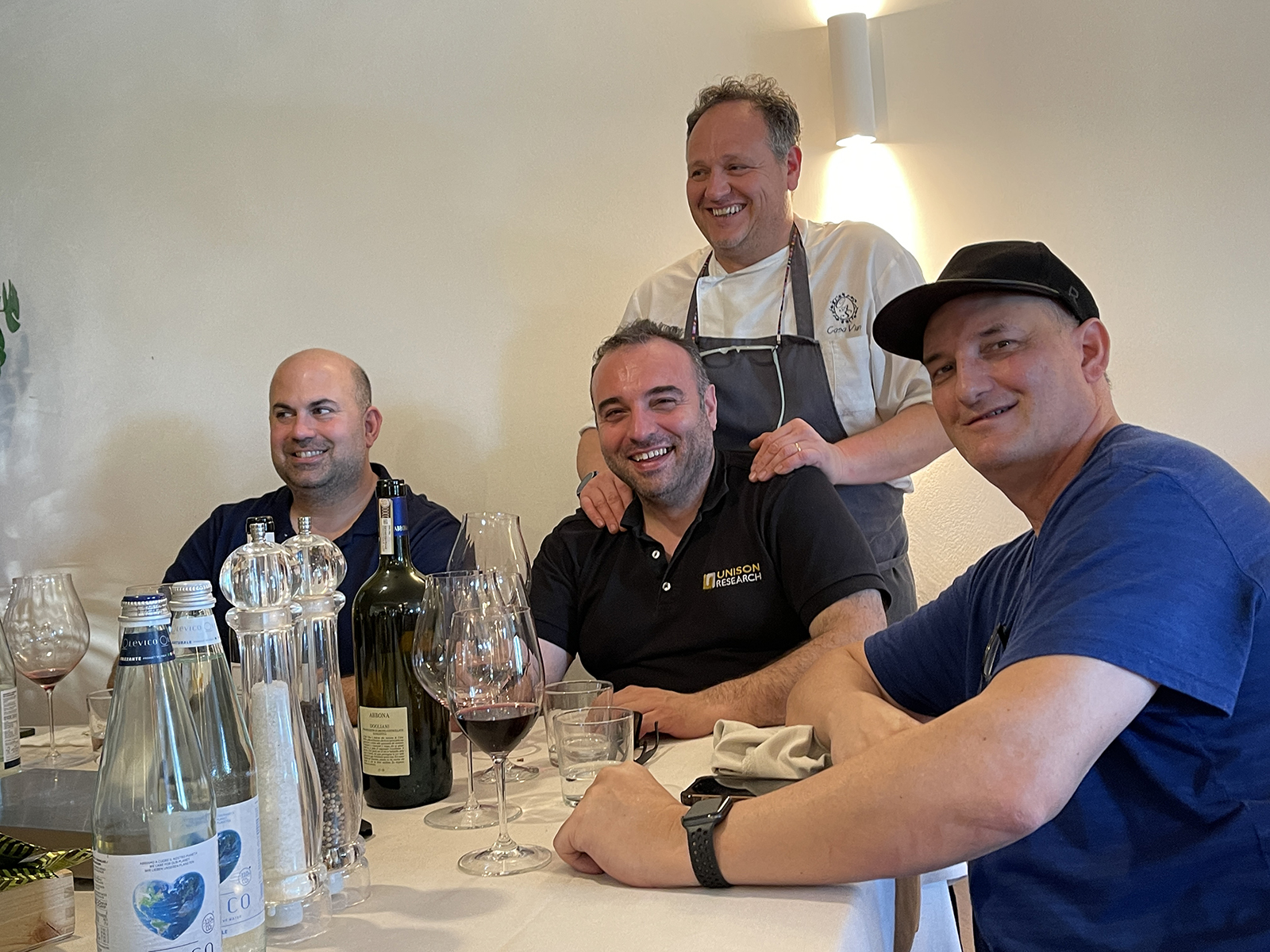
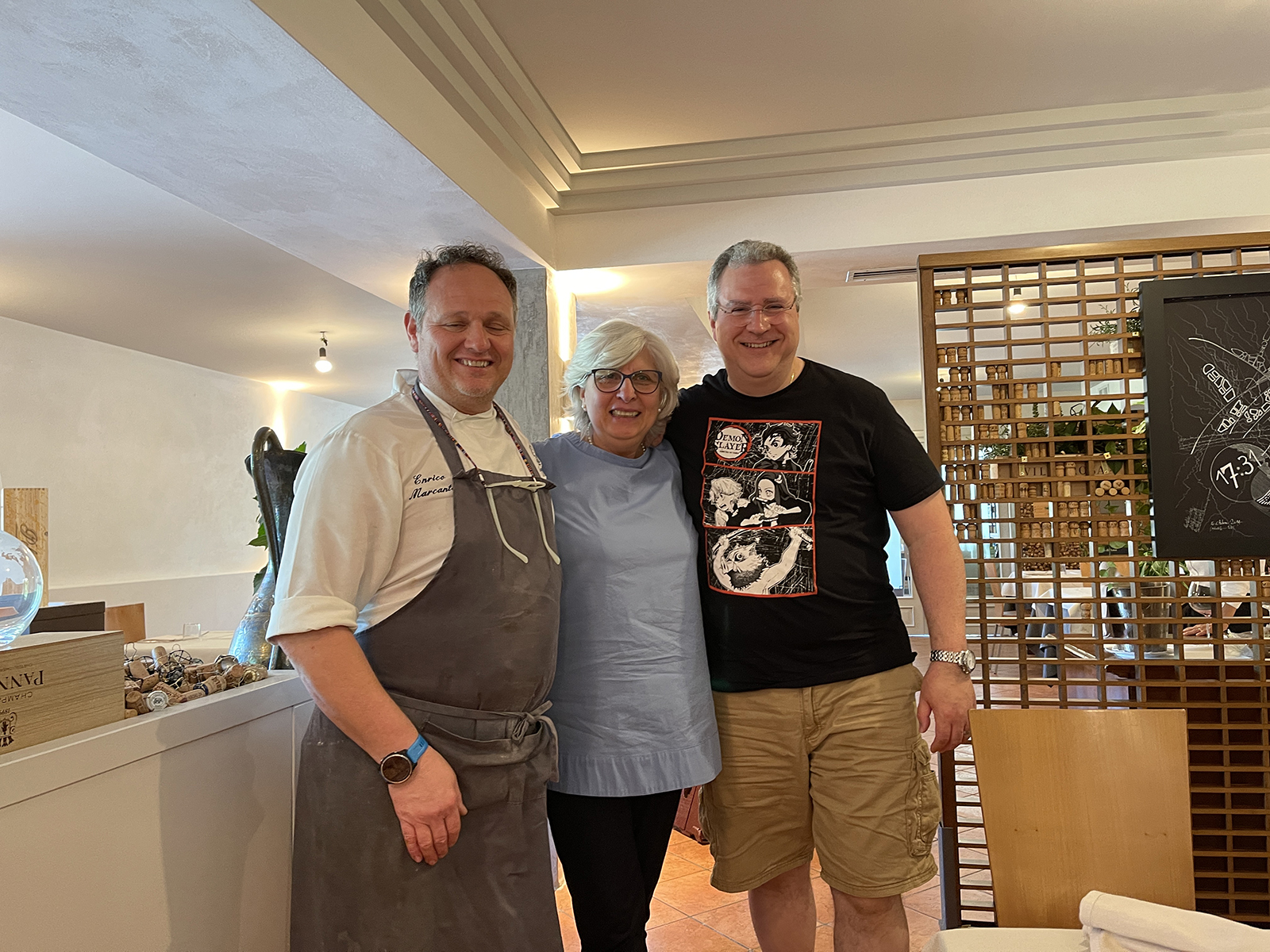 For here was this most genuine and charming family, having started a loudspeaker company over 40 years ago for the love of music, still carrying on the tradition and wanting to share that story, that passion for what they do with us and the wider world. One can’t help but be touched very deeply by their desire to produce the best that they are able and share that. When one sees and experiences what this family is about, it adds so much more depth and meaning to just a lovely integrated tube amp or an artfully made pair of speakers. To people like me, it makes these audio things we covet so much all the more priceless. Plainly speaking, these folks make art.
For here was this most genuine and charming family, having started a loudspeaker company over 40 years ago for the love of music, still carrying on the tradition and wanting to share that story, that passion for what they do with us and the wider world. One can’t help but be touched very deeply by their desire to produce the best that they are able and share that. When one sees and experiences what this family is about, it adds so much more depth and meaning to just a lovely integrated tube amp or an artfully made pair of speakers. To people like me, it makes these audio things we covet so much all the more priceless. Plainly speaking, these folks make art.



